
ABOUT UAT
University of Advancing Technology is an elite, private college that serves its student body by fostering knowledge creation and academic excellence in an environment that embraces the young technophiles of the world. With three centers of research and a suite of technology-centered undergraduate and graduate degrees, the University is a recognized leader in technology education.
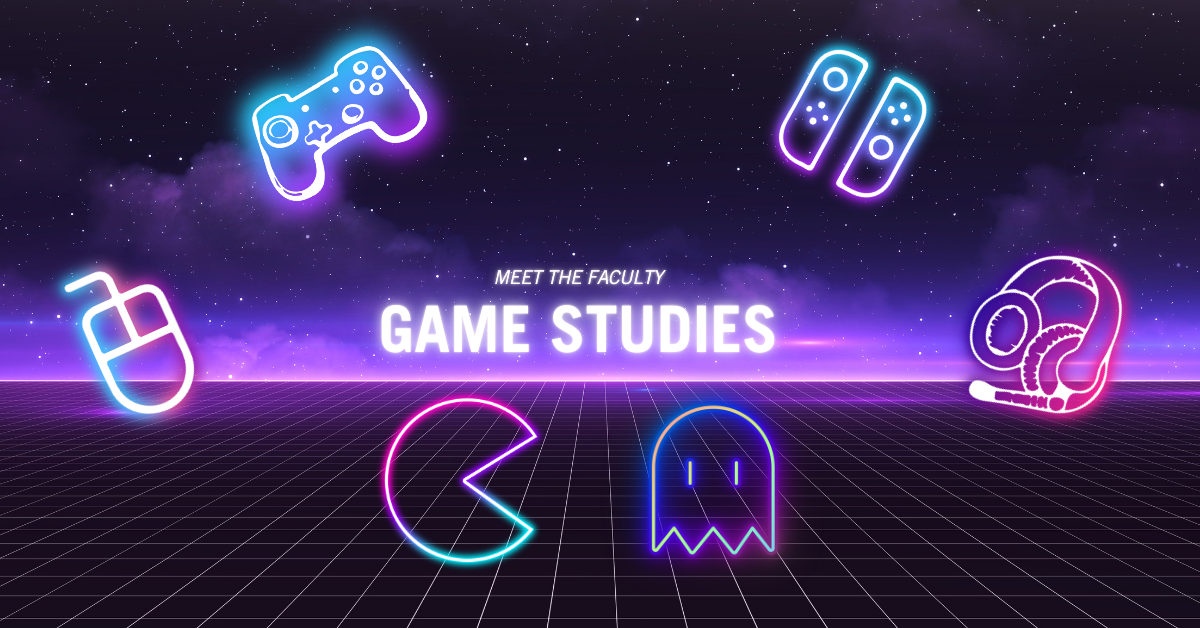
The Game Studies Faculty at University of Advancing Technology (UAT) is dedicated to fostering innovation and excellence in game design, development, and production. UAT's game studies degrees emphasize creativity and real-world application, ensuring graduates are well-equipped to thrive in the ever-evolving gaming industry. With state-of-the-art technology and a curriculum that adapts to industry trends, this group of faculty prepares students to become the next generation of game developers and designers.

Professor Clark has the passion and talent to work within multiple areas of technology and find the opportunities in the intersections of technologies in order to solve problems or find innovative solutions that create new products. He has a longstanding history at UAT beginning in the early 90's as a student who then made UAT his home as a member of Faculty in 1997. One of his greatest strengths is looking at situations from different perspectives and applying different models of thinking to arrive at creative solutions. Throughout his tenure at UAT, he has applied these abilities to create curriculum, programs, software, and projects resulting in successful completion and positive impacts to those involved, both clients and colleagues. Professor Clark specializes in game program development, product development and project leadership.

Dr. Henry, a fixture at UAT since 2014, has always had a firm belief that gaming - video games in particular - can be used to change the world for the better. In addition to teaching Game Design and Programming at the college level, he studies how educators and corporate trainers can take advantage of games and video-game technologies to improve learning, retention, transfer, and performance. In other words: he's interested in building games that help players "level up" in real life. Dr. Henry specializes in Game Design (content/narrative design and systems design), scripting/programming, project management, team leading, production and GSD/TCOB.

Professor Jacob Hreshchyshyn joined UAT in 2023 as a Game Programming Professor. His interest in game development led him to pursue a Bachelor's in Software Engineering with a certificate in Computer Gaming, allowing him to develop experience in Agile methodologies, design patterns, and programming paradigms while developing game projects. Following the completion of his Unreal Engine 4 Creative Project for Barrett, The Honors College, he obtained a Master's in Software Engineering with a ProQuest publication on Game Development for Smart Twisty Puzzle.

Professor Marquit has over 13 years of game industry experience both teaching and creating professional quality art for video games. He has worked for both Rainbow Studios (THQ) and Big Bang Entertainment (Sony Online Entertainment). During Professor Marquit's time with these companies he shipped 6 games including Pixar's Cars, Free Realms and Star Wars Clone Wars Adventures. He has also worked as a free lance artist doing such things as graphic design, web development and architectural renderings.
Professor Marquit started teaching in 2008 at Collins College in both their Game Production and Graphic Design degrees. He quickly learned to love teaching and it has since become a passion. He then brought this passion to UAT in 2013.

Professor Portillo joined the UAT Family in 2012, and teaches Game Art & Animation with a specialty in project management, course development, 2D and 3D game art asset creation, and production. Aside from teaching, he owns Thinkjorge Designs specializing in advertising art and assisting with art direction for technology start-ups
Specialties:
Game Project Management
Game Art & Animation Course Development
Design Consulting
3D and 2D Design Aesthetics
Graphic Design
Game Asset Creation & Integration
Web Design

Ralen Watson-Davis is a seasoned veteran in game art and animation Since 2017, he's been a part of UAT from going through his undergrad and graduating in 2020, working as a Program Support Specialist from 2020 until he completed his Master's Degree in Game Production and Management in 2024, then making the leap to UAT Instructor. He is a versatile and skilled artist in many forms and mediums such as 3D Modeling, Texturing, Designing, Digital Artworks, Animation, Traditional Art, and plenty more. His preferred work of choice is Animation and Concept Art, but loves doing any form of work that he can do. He's done outsource work for his skills in art and is always looking for new opportunities to grow his skillset and improve. He also has plenty of hobbies, one of his favorites being the guitar. Feel free to talk to him for anything art related, or if you would just like to chat!
Check out UAT's Game Studies degrees!
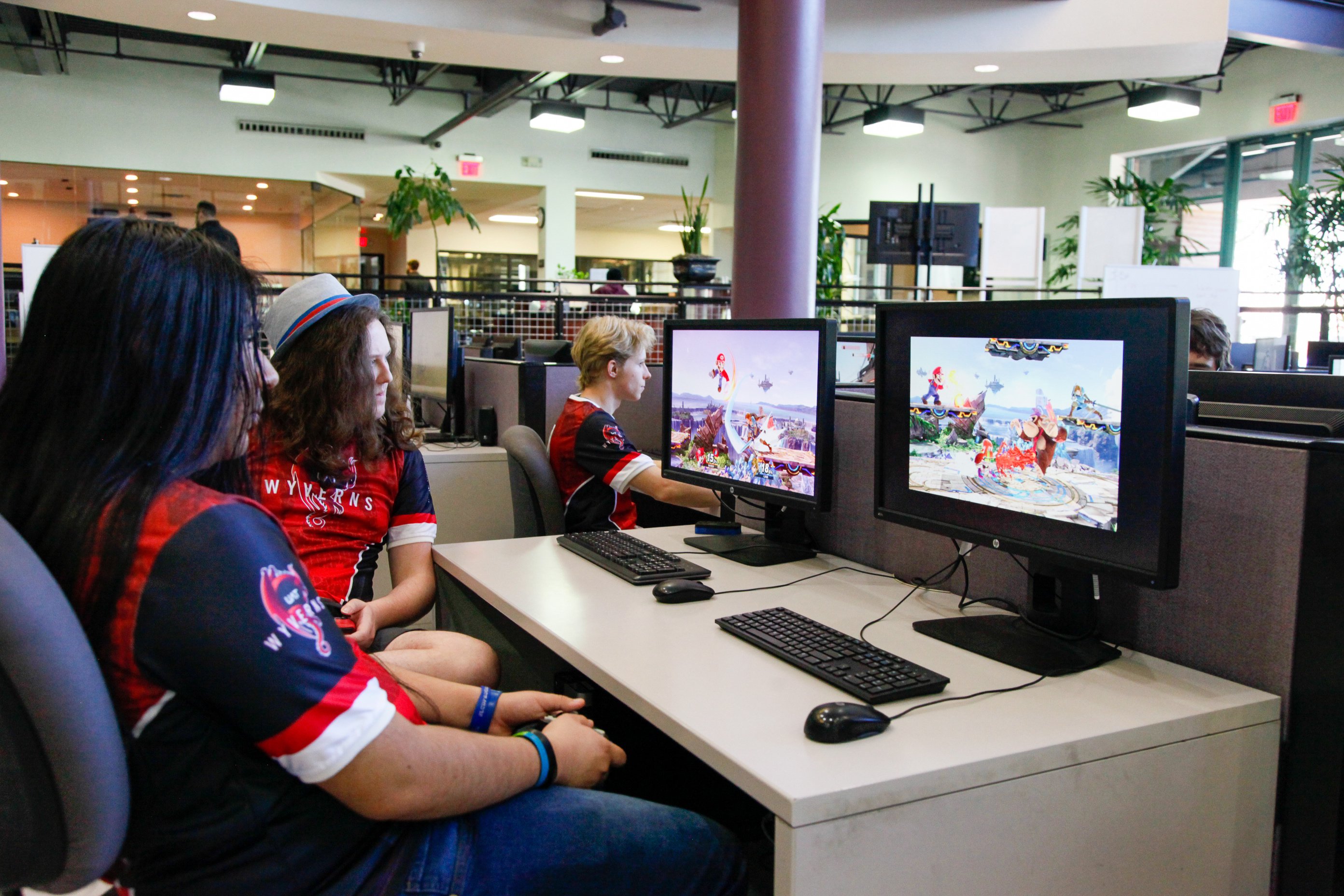
Game development is a constantly evolving industry, where technology, talent, and design principles shape the next generation of interactive experiences. From AI-driven content generation to innovative hiring strategies, let's explore key insights into modern game development.
Artificial Intelligence (AI) in Game Development
Artificial intelligence is revolutionizing game design by enabling dynamic content generation, including engaging narratives and dialogue systems. While AI enhances creativity, it does not replace human designers. It serves as a tool to elevate storytelling and interaction.
One way the industry keeps AI at bay, and employs more creative humans is through outsourcing. Game development companies thrive on a mix of in-house talent and outsourced expertise. Different game development roles—such as concept artists and game designers—have unique outsourcing needs, making it crucial to identify the right talent for each task. Contractors also provide a viable entry point for newcomers looking to gain experience and get into the ever-competitive game industry.
User Experience (UX) in Game Design
UX extends beyond User Interface (UI) design; it encompasses interaction, accessibility, and overall player experience. Games like Beat Saber and Dance Dance Revolution are excellent examples of intuitive UX design. Tools like Miro and Figma help in prototyping and refining design flows, ensuring a seamless user experience.
Miro and Figma aid in feature design and prototyping, but how do developers determine when a feature is truly complete? The ‘Test for Completion’ (TFC) methodology provides a checklist approach to ensure that a feature meets design goals before final implementation.
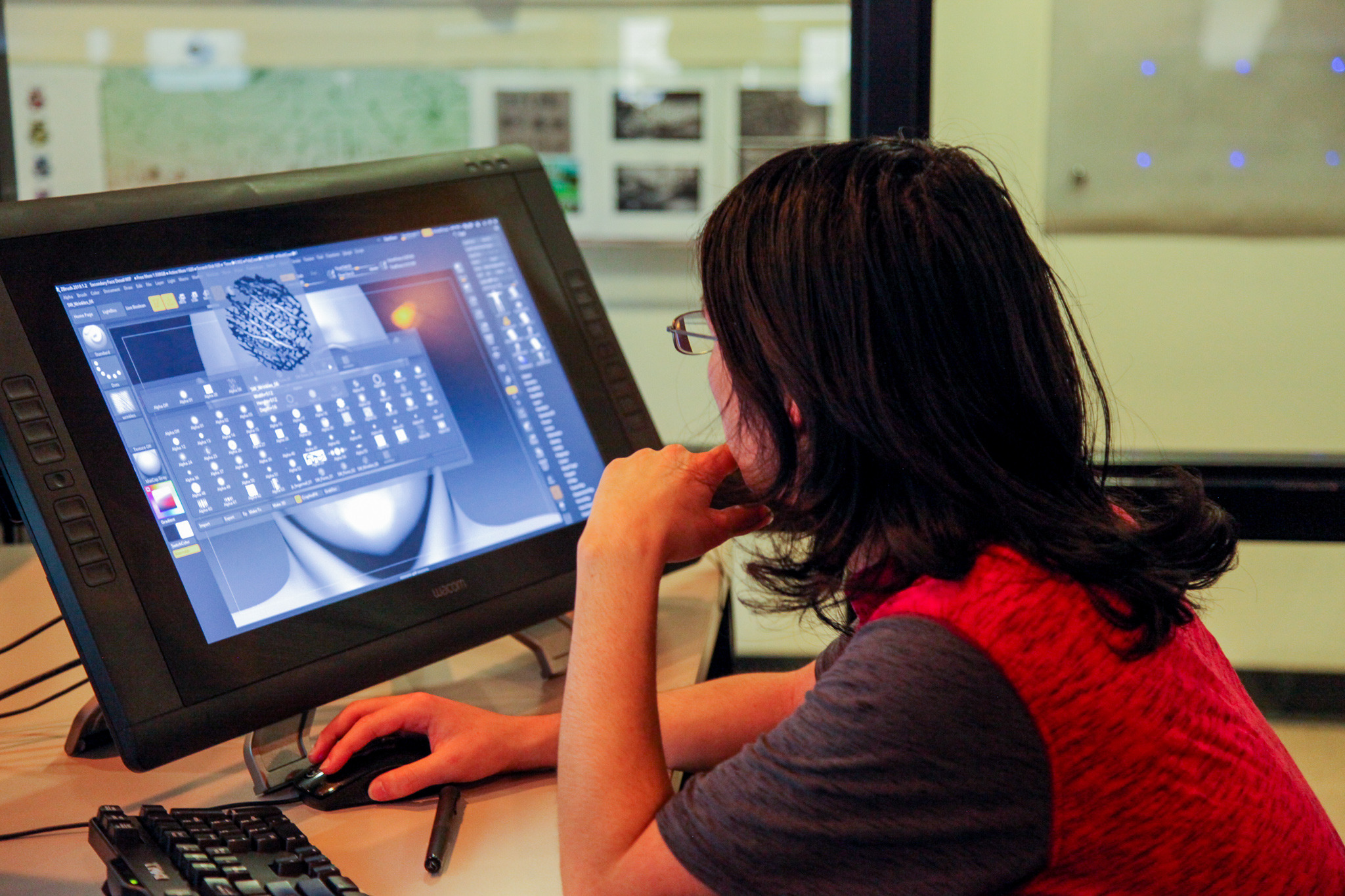
Steve’s Hiring Approach + Tips for Candidates
When it comes to hiring, problem-solving ability often outweighs specific experience. Steve Merka, Game Director for Sony Entertainment, has an informal yet insightful evaluation process, which prioritizes passion and compatibility. Engaging candidates through casual conversations helps assess their problem-solving skills and cultural fit more effectively than traditional interviews.
The best candidates excel in collaboration, communication, and independent problem-solving. Attitude and growth potential matter just as much as technical expertise. Passion for game mechanics is another key factor—after all, game development is not just a job but a craft that thrives on creativity and curiosity. Another crucial element is a strong portfolio showcasing prior work. Employers look for candidates who can not only design innovative systems but also articulate their design choices.
Learn more about all of UAT's Game Studies degrees today!
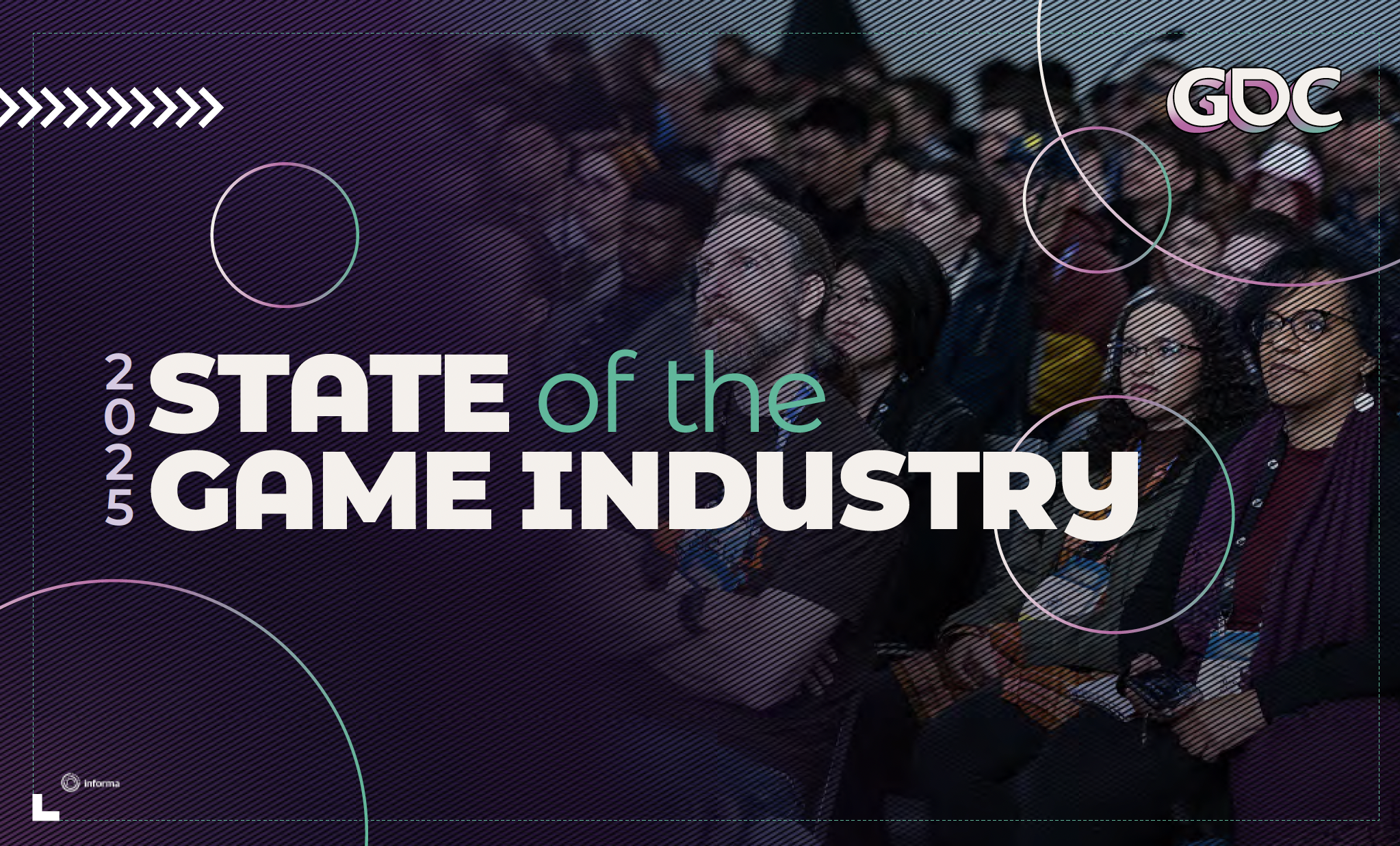
The “2025 State of the Game Industry” report offers a compelling snapshot of a field that’s both flourishing and facing challenges. While the industry has experienced significant layoffs, it’s also seeing growth in areas like PC development, improved accessibility features, and a rise in diverse voices—including women, non-binary, and LGBTQ+ creators. According to the data (see image above), 32% of game developers now identify as women or non-binary, while 24% identify as part of the LGBTQ+ community. These shifting demographics signal a more inclusive future for both players and developers.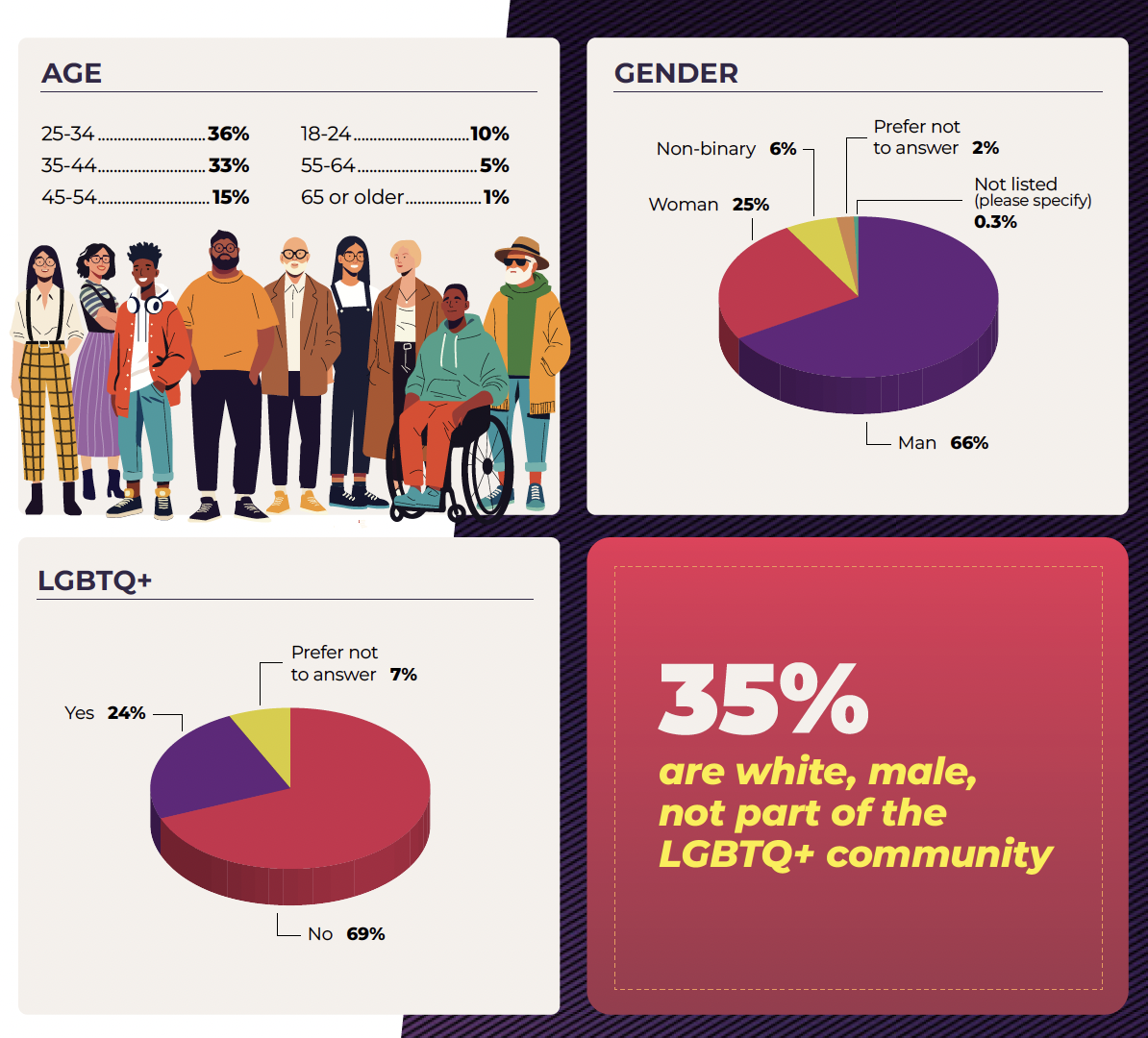
Despite ongoing layoffs, game design, programming/engineering, and production remain the most common career paths in the industry. The report highlights that studios and publishers are restructuring teams, with many developers noting the importance of agile project management and interdisciplinary collaboration.
The report also reveals that PC remains the dominant platform for developers (at 80%), followed by popular consoles and mobile. Interestingly, emerging platforms like VR/AR and subscription services (e.g., Xbox Game Pass) continue to gain traction, opening new avenues for content creation and monetization strategies.
In response to these trends, the University of Advancing Technology (UAT) continually updates its curriculum to ensure that our Game Studies degrees align with industry realities. Here’s a sneak peek at some of our evolving courses:
GAM200: Critical Game Studies
Dive into the cultural, social, and historical contexts of gaming, learning how audience expectations and market shifts shape the design process.
GAM218: Game Scripting for Designers
Acquire hands-on scripting skills to bring game mechanics and prototypes to life.
GAM310: Level Design
Build immersive, engaging environments, honing the skills needed to meet the industry’s growing demand for robust, player-focused experiences.
GAM352: Game Systems Design
Delve into the nuts and bolts of game systems, including economy balancing and systems thinking—essential for any modern developer.
GAM395: Monetization Design and Strategies
Explore various monetization models and strategies, from free-to-play to subscription services, all while keeping player experience at the forefront.
GAM418: Deployment Strategies and Project Constraints
Learn how to manage production pipelines, optimize for specific platforms, and navigate real-world constraints like budgets and timelines.
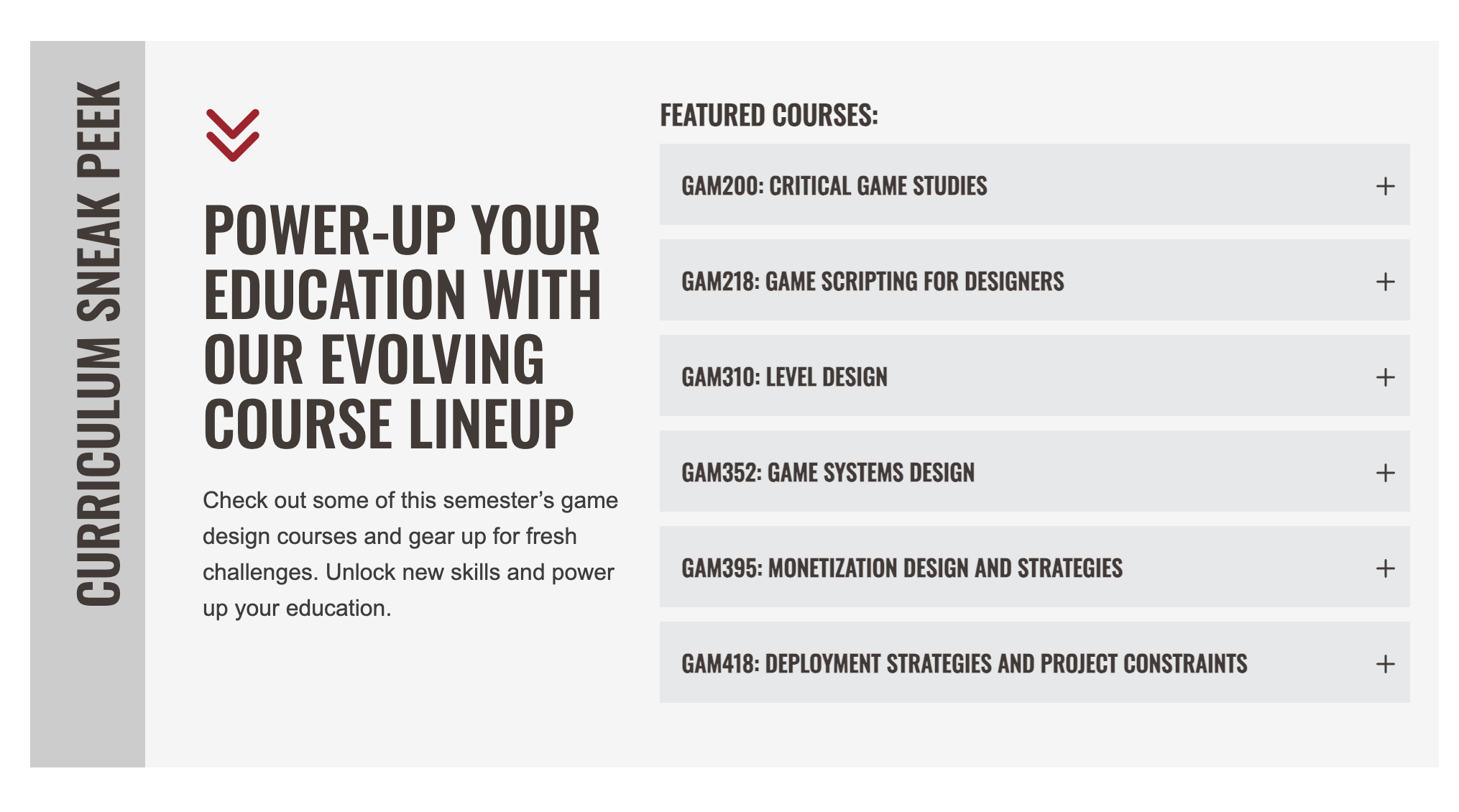 In the following video, Professor Matthew Marquit takes a deep dive into our comprehensive Game Studies programs—covering everything from Game Design, Game Art and Animation, and Game Programming at the undergraduate level, to our graduate degree in Game Production and Management. Each path equips students with the skills and knowledge needed to thrive in today’s competitive industry.
In the following video, Professor Matthew Marquit takes a deep dive into our comprehensive Game Studies programs—covering everything from Game Design, Game Art and Animation, and Game Programming at the undergraduate level, to our graduate degree in Game Production and Management. Each path equips students with the skills and knowledge needed to thrive in today’s competitive industry.
Why UAT?
Whether you’re aiming to be a game designer, programmer, or producer, UAT’s Game Studies programs equip you with the skills and mindset to thrive in a field where change is the only constant. From understanding the latest technologies and trends to honing the soft skills that help you lead teams, you’ll graduate ready to make an impact.
Ready to Level Up Your Career?
Explore our Game Studies degrees and see how UAT can help you become a part of this dynamic, evolving industry.

During this year’s Global Game Jam (GGJ), you could find various gamers crashed out, sleeping on the floor around campus, and working tirelessly toward creating their masterpieces.
Organized in-person, via Microsoft Teams and Discord, University of Advancing Technology (UAT) was one of many game sites across the world hosted by our talented Gaming Regent and veteran Professor, Derric Clark, and regional organizer, Adam Moore. Participants were not required to have experience, and they were not given the theme until the Jam kicked off on Friday, January 24, at 5:00 p.m.
Gamers were treated to a Keynote address featuring various leadership and organizers for Global Game Jam. Watch the Keynote and Theme Reveal Video:
The 2025 theme chosen by a panel of industry professionals was 'Bubbles' and jammers from across the globe all created fresh new games incorporating the many facets of bubbles, from bubble wrap to bubble gum. The UAT Jam Site participants submitted 10 games, with 8 presenting live via Zoom on Sunday for judging. See the full UAT site and all uploads at https://globalgamejam.org/jam-sites/2024/university-advancing-technology
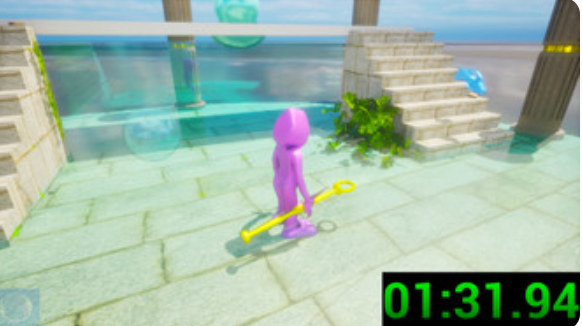
Bubble Watch (pictured above) used magic to create bubbles and fight monsters to reach the end of the level as quickly as possible. UAT, known for having one of the largest game studios in Arizona, played host to over 30 gamers during the event. Here are the winners for the UAT site!
Find all of the games as well as the team members who worked on them at as they catch up on rest and upload their bubbly creations this week.
https://globalgamejam.org/jam-sites/2024/university-advancing-technology
Find all you need to know about the Global Game Jam at https://globalgamejam.org/faq.
Considering a career in gaming? Check out the following for more information about our suite of UAT game development degrees.


On the sixth day of Techmas, we’re spotlighting the six-degree suites at University of Advancing Technology (UAT). These distinct yet interconnected areas of study define the innovative, hands-on educational experience that sets UAT apart. With a focus on preparing students for the careers of tomorrow, each suite is tailored to explore cutting-edge technologies, foster creativity, and develop expertise in fast-growing industries.
If you’re drawn to building, designing, and imagining futuristic solutions, the Creation & Simulation suite is your calling. From Digital Maker and Fabrication to Robotics and Embedded Systems and Human Computer Interaction, these degrees empower students to bring ideas to life, pushing the boundaries of technology and usability.
Ranked #1 in Computer Science in Arizona, UAT’s Software Engineering family develops leaders in technology through degrees in Advancing Computer Science, Artificial Intelligence, Data Science, and a Master’s in Software Engineering. Students master coding, machine learning, and the art of problem-solving, preparing to innovate in fields that drive the digital world.
The Cybersecurity suite offers cutting-edge degrees in Network Engineering, Network Security, Technology Forensics, and a Master’s in Cyber Security, arming students with the skills to protect systems and data from cyber threats. UAT graduates are highly sought after in this ever-evolving industry, where demand for cybersecurity expertise continues to rise.
For creative minds, the Digital Arts suite offers degrees in Advertising Art, Digital Marketing, and Digital Video. These programs blend artistic expression with technical expertise, preparing students for dynamic careers in media, branding, and content creation.
The Game Studies suite immerses students in the world of interactive entertainment. With degrees in Game Art and Animation, Game Design, Game Programming, and a Master's in Game Production and Management, UAT cultivates the next generation of game developers ready to shape this billion-dollar industry.
Future leaders find their niche in the Business & Innovation suite, featuring degrees in Business Technology, Technology Studies, and Master's degrees in Technology Innovation and Technology Leadership. These programs combine entrepreneurial thinking with technical skills, equipping students to drive change in tech-driven industries.
As UAT celebrates innovation this Techmas season, these six degree suites highlight the diversity and depth of education that UAT provides—ensuring every student has the tools to thrive in the tech careers of the future.

UAT student Baylee Balsimo Ketelhut describes her process working through this Ancient Envinronment across two Game Art & Animation classes with UAT Professor Jorge Portillo. He stated "She made all the 3D models in GAA220, Environment and FX using 3Ds Max and Maya and Textured it in GAA240 Texturing, this environment came out Epic!"
For this environment, I started with gathering a ton of references from my own photos to 3D models on ArtStation. The art style I referenced the most was from Ghost of Tsushima/Sekiro. I came to the conclusion that I wanted to make a secluded river town that lived off the base of a waterfall.
I began modeling the simple props, such as Torii, stone statues, lanterns, etc. Then came modular walls and floors, where I made outdoor walls and architecture for a Kyoto-style home. I made sure that every section looked like it was supposed to be divided to make the buildings look more believable when staged in engine.
For the organic models, the first items were 3 rocks I sculpted using an outsourced 3dsMax tool call MultiMesher. While they are difficult to notice in the environment at first, I used them to make my cliffs and mountains more dimensional. I do that by staging them throughout the edges of cliffs and terrain walls. As for trees, I made a bamboo tree, a shrub, a wisteria tree, and a bamboo cluster tree. These were modeled mostly using curves in Maya, while the grass, leaves, and flowers were all made with alpha textures and staged manually or with MASH in Maya.
The last two things I did with this environment was the complex props and center piece. I made a fish fountain, a dragon spout, and some other props that I didn't have time to texture. For these, I used a combination of Maya sculpt tools and the Quad Draw tool (my favorite!). For any facial structure I tackled, such as on the dragons, I used the Quad Draw tool to create custom topology for the eyes, nose, and mouth. The dragons each have spikes which I used MASH to procedurally duplicate them along the curve of the dragon's spine.
The hardest part, of course, was the center piece itself, which was a giant statue with two dragons. I kid you not, I studied every reference I could find on the internet for 2 hours trying to figure out what was happening in the statue. I decided to go more simple to protect my sanity, and added spirals/scales through textures and normal maps.
As for texturing, I created each texture from base-images (such as cement) and added a lot of painting/filtering to them in Photoshop. Most items consisted of trim sheets, totaling up to around 5 modular texture sheets. Other textures include ~8 tiling terrain textures, and over 10 UV mapped textures. All of which had normal maps applied in Substance Sampler.
Lastly, everything had to go into Unity! I made a terrain, painted the textures, and slowly added more depth/mountains over time. I staged everything to match the initial concept, added water, and falling particles from the trees. I also didn't manually place every tree, I used the terrain tool where you can paint trees.
Check out UAT's Game Art & Animation and other degree options here.

For Hope Thoms, the Student Innovation Project (SIP) was a chance to create change for women in STEM as well as an opportunity to honor the memory of a beloved family member.
Originally from Ridgecrest, California, Game Design major Hope has journeyed far—both geographically and intellectually—to complete her SIP. The inspiration for creating FemInspire, a social media app designed to connect girls and young women with female mentors, can be traced back to a seed of an idea planted in her childhood.
Hope enjoyed playing sports as a child and loved participating in hands-on, scientific endeavors. However, she felt that her interests made it difficult to connect with other girls and notes that she mostly had male friends growing up as a result.
“It’s definitely something that inspired me to create an application like this because mentorship is important,” Hope said. “But so is community.”
Hope was also motivated to create FemInspire in memory of her late aunt, who worked in information technology. After surviving a battle with breast cancer, Hope’s aunt passed away a year later, due to complications caused by stress. Knowing her aunt dealt with harassment at her workplace and was isolated as a woman in STEM, Hope feels even more determined to prove the importance of and foster female connection in male-dominated spaces. Further, she feels that supporting women in these fields will create better applications, products, and experiences across the field of technology. Particularly, Hope highlights the need for more women working in the video game industry.
 “Diversity makes great games,” Hope asserted. “I'm making FemInspire because women want that diversity, because women want to hear women’s voices. There’s an imbalance that I want to help resolve, because it shouldn't exist—but it does even now, in 2024. It's still there, it’s still a problem. And it's probably going to be a problem for a very long time.”
“Diversity makes great games,” Hope asserted. “I'm making FemInspire because women want that diversity, because women want to hear women’s voices. There’s an imbalance that I want to help resolve, because it shouldn't exist—but it does even now, in 2024. It's still there, it’s still a problem. And it's probably going to be a problem for a very long time.”
Hope had to learn a number of new skills and programs in order to create her FemInspire prototype. She designed the mobile app’s interface using Figma, and took great care with choosing the color scheme and look of the app. She chose blue and purple as the color scheme, wanting to avoid passé pink. And despite not having an art background, Hope pushed herself to design and refine FemInspire’s logo until she was satisfied.
Hope also consulted with a number of UAT faculty and students in the completion of her SIP. While she feels grateful for the practical lessons gained within the classroom, Hope ultimately feels that the most important lesson she learned in her college experience was the need for resilience.
“I'm a very driven person,” Hope explained. “If I need to do something, I will just do my best to accomplish it. I’ve developed a kind of ‘iron it out as I go’ philosophy. Every single UAT class I've taken has been fast-paced, and with life and work, it's hard to balance. But at the end, I have to figure it out. Whether the solution is talking to a professor, or conducting some research, every single class here has taught me the need to be a problem solver.”
Looking to the future, Hope is invoking her namesake and feeling optimistic about her life and career prospects after graduating later this summer. She plans to stay in the Phoenix area for some time, noting that the city has become an emerging technology hub. She’s considering relocating to the east coast, where most of her dream video game publishing and development companies are located. She’s also keeping an open mind for the stepping stones that could take her where she wants to land.
“I'm the kind of person who if I don't get to work my dream job immediately, that's okay with me,” Hope insisted. “Because I am very persistent and passionate.”
Embark on Your Academic Adventure at UAT
Did this student’s story ignite your interest in UAT? Now is the ideal time to inquire further or even apply for admission! Whatever stage you are at in your academic journey, UAT’s approachable Admissions and Financial Aid teams are ready to provide support and assistance. Step into your future by connecting with us today.
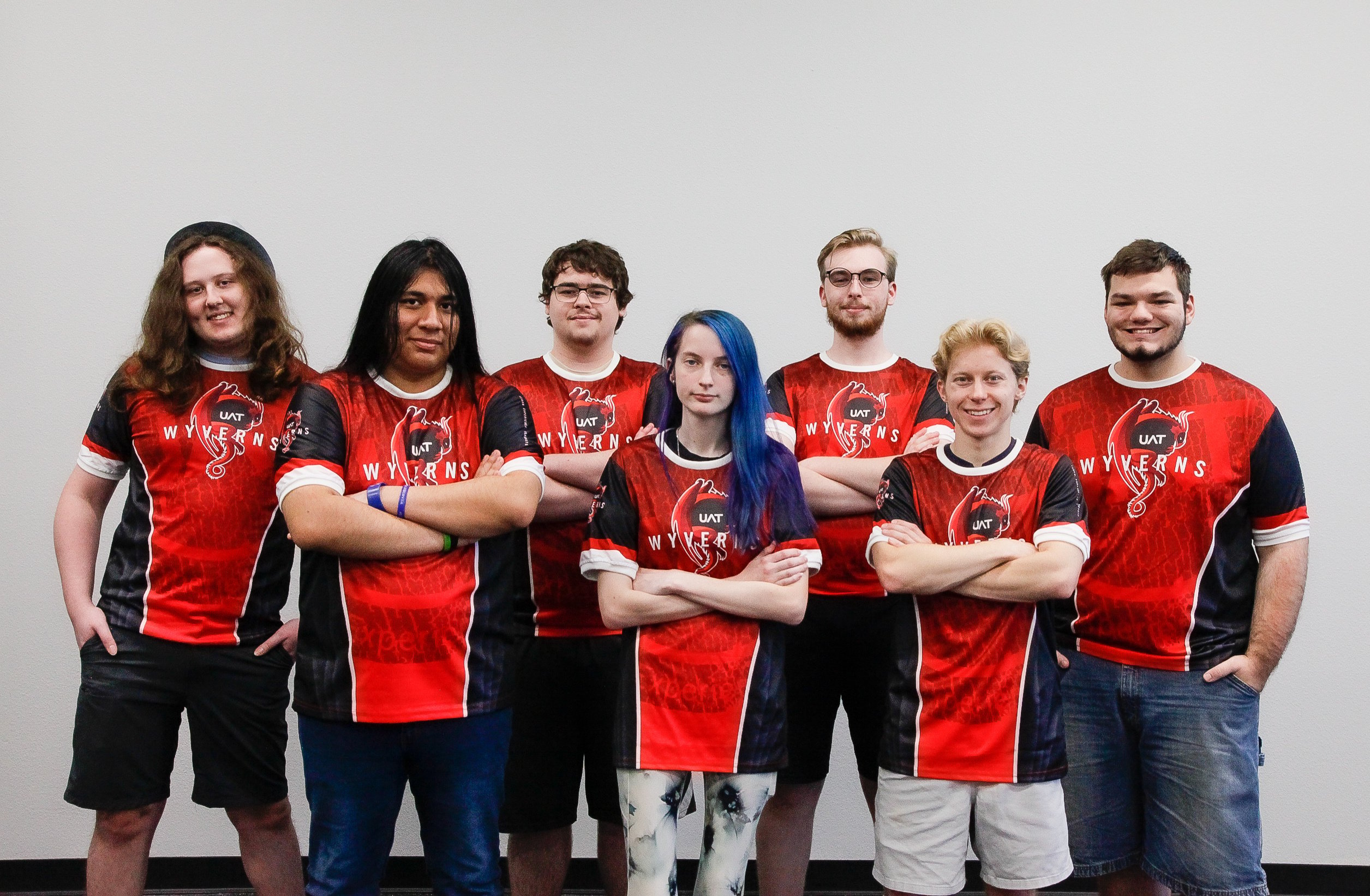
We’re excited to share that University of Advancing Technology (UAT) has been ranked the #2 College in Arizona for Game Design Degrees by Animation Career Review for 2024! This recognition highlights our commitment to providing top-notch education and hands-on experience in Game Studies.
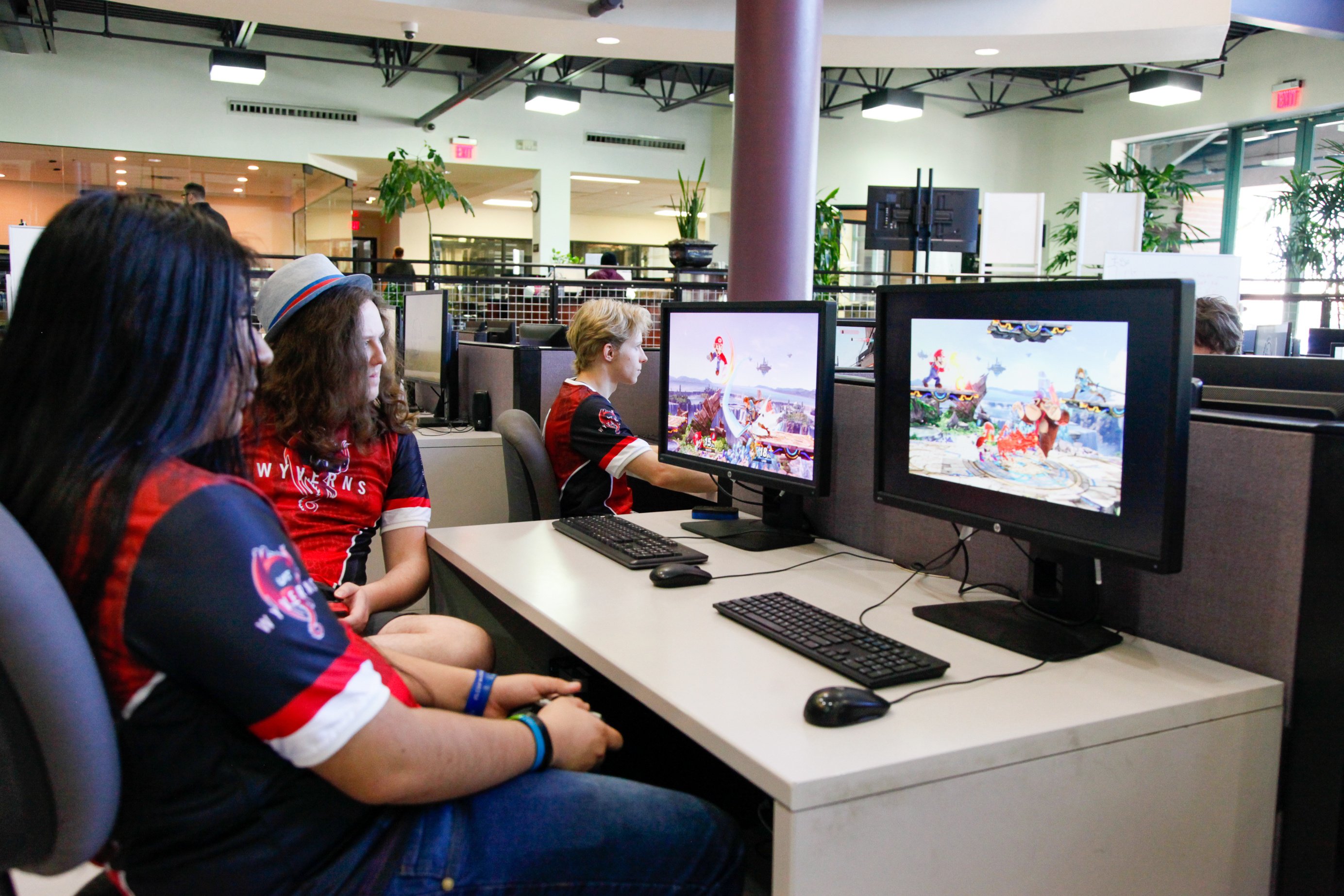
Animation Career review says "UAT houses one of the nation's only fully accredited game design programs that provides degrees across the discipline." UAT's Game Studies degrees include three different bachelor degree options and a master's degree:
Game Art & Animation BA - Students will focus on creating 2D and 3D art and animations for various platforms including PC, console, mobile, online, and VR. They will master artistic principles such as color theory, lighting, and anatomy, and develop skills in low- and high-polygon modeling, texturing, rigging, and motion capture animation.
Game Design BA - Students learn to build and create full game projects while collaborating with peers and faculty along the way.
Game Programming BS - Students begin with core programming principles and then focus on game-specific techniques. The program highlights C++ and C# programming, scripting, data management, AI, networking, and industry-standard tools. Students also develop a critical perspective on gameplay and design.
Game Production & Management MS - UAT Master of Science degrees are designed to align with rapid technological advancements, offering top credentials and an environment that fosters interdisciplinary collaboration and innovation. Students develop critical evaluation skills and contribute original research in their fields.
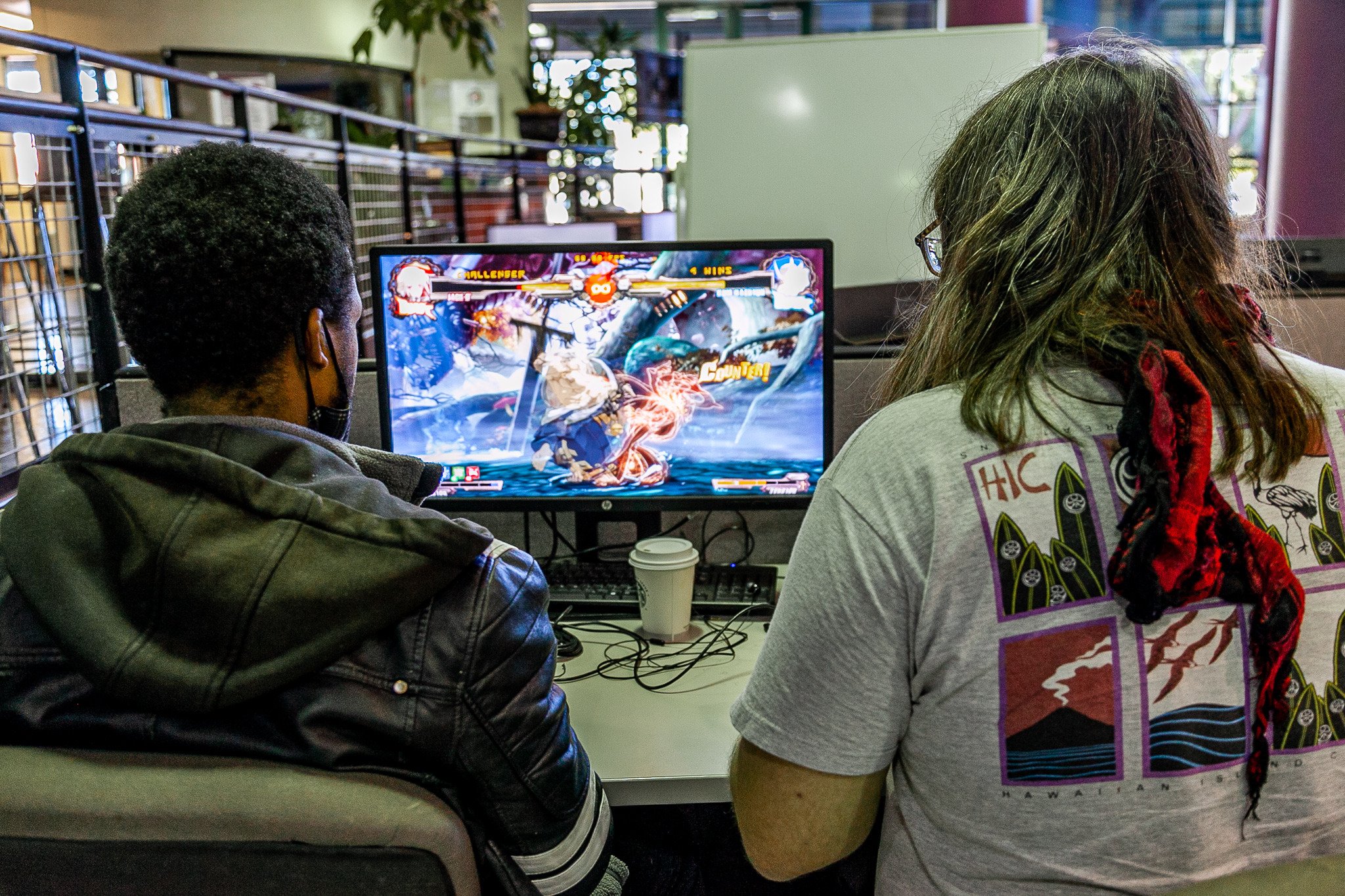
The University of Advancing Technology (UAT) is proud to showcase the Spring 2024 Student Innovation Projects (SIPs) from the Game Programming and Game Design majors. These projects represent the culmination of students' academic journey, highlighting their ability to address real-world challenges and push the boundaries of technology in the gaming industry.
Hope Thoms' FemInspire is a groundbreaking social application focused on supporting women in STEM through mentorship, earning recognition with the prestigious World Changer Award.
Trevor Baughn’s Responsibility introduces a dynamic reputation system driven by game AI, enhancing the depth and complexity of NPC interactions within games.
Musical Towers is an innovative rhythm-based tower defense game designed to make music creation an integral part of gameplay. Unlike traditional games in this genre, Musical Towers allows players to generate original music by strategically placing towers that harmonize or discord with each other. This engaging approach not only entertains but also educates, helping users understand musical concepts like harmony and discordance. Ideal for both children and adults, the game aims to bridge the gap in music education accessibility, making learning about music fun and interactive.
Zac Habul’s Backseating introduces a novel game mechanic that splits control between the player and their character, enriching the narrative experience in narrative-based games.
My SIP is a way of 3d modeling so that models have action figure articulation for the purpose of achieving a unique art style for a video game.
STEX-rs — the shader template exporter — a utility for game developers to use the same core shader across multiple game engines.
Pierson Mcinelly’s Virtual Podcasting Camera revolutionizes podcasting in virtual spaces, offering advanced virtual camera techniques for streaming and recording podcasts.
Collin Strauch’s software for generating pixel art character animations streamlines the animation process for game developers, providing a user-friendly tool for creating captivating sprite-based animations.
Adam White’s Baked Directional Gravity introduces a groundbreaking approach to game physics, enhancing the realism and dynamism of virtual environments.
The Spring 2024 Student Innovation Projects from UAT's Game Programming and Game Design majors exemplify the program's dedication to fostering innovation and equipping students with the skills needed to thrive in the ever-evolving landscape of the gaming industry. These projects not only demonstrate students' technical expertise but also their creativity and ability to address societal challenges through gaming.
Learn more about how Student Innovation Projects contribute to career readiness, here.
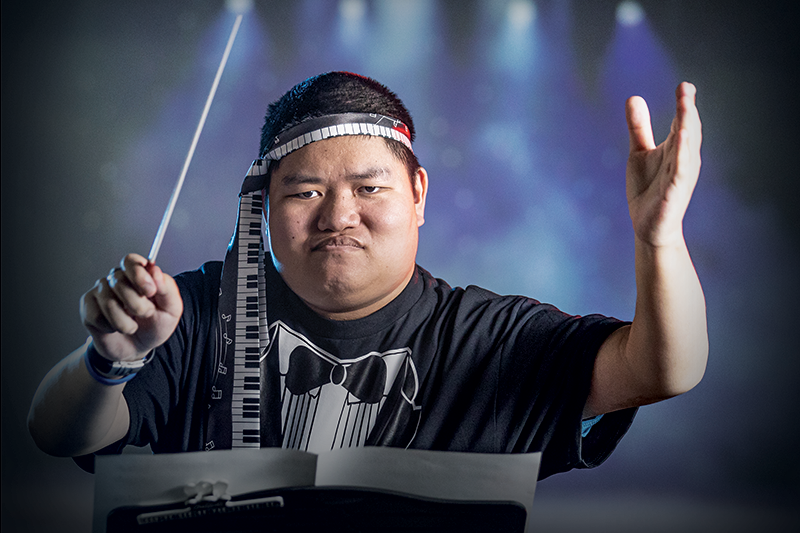
Team Member: Sam McKinley, Game Programming
Sight-reading and ear training are important skills for band, orchestra and choir. But when it comes to learning and playing music, these skills aren’t typically taught until middle and high school. Playing instruments from a young age, Sam McKinley, a Game Programming major, discovered that when it’s taught earlier, it’s easier for students to understand music. This is where his Student Innovation Project (SIP), Music in Me: Mega Melody, comes into play, teaching sight-reading and ear training to grades 3-5.
Notably, Sam was active in the jazz and honor bands and part of many different music groups throughout school. He learned the clarinet in fifth grade and tenor saxophone in seventh grade.

“I noticed that when these topics are taught, people have that lightbulb moment, and realize they might actually be good at this. I wanted to create those moments; I wanted to help people get to that point. I found the easiest way, other than teaching them in person, was teaching them through games. I was raised with so many educational games, and through those, I learned so much more.”
Raised by an elementary school teacher, Sam’s mom was a huge inspiration. He notes, “The thing that spawned the idea was watching her kids learn the very beginning instruments, like the recorder. And through that, I had the idea that I want to help with this, but I can’t because of my own disabilities.”
A familiar face around his mom’s classroom and the elementary school, Sam’s passion over the last couple of years was teaching kids all things music and instruments. Until his vertigo set in, he was part of the after-school program, teaching music and general studies, and consistently helping in classrooms throughout the day.
“Because my mom was there all day, she would bring me. I was even asked to help with kindergarten and grades one and two. That was actually my passion; I just can’t keep up with those kids anymore,” Sam states.
Music in Me: Mega Melody was mainly built in Unity using Visual Studio and C# development. Attributing most of his programming knowledge to University of Advancing Technology (UAT), Sam came to the University with a very basic understanding of game programming. Professors Tony Hinton and Adam Moore helped unlock Sam’s potential.

Without an animator helping with the project, Sam took on learning how to edit sprites to make the game interactive via different character features and movements. Professor Adam Moore was a huge help with this aspect, as he introduced Sam to the possibilities with sprites and cohesively implemented many ideas into the game build. Sam also credits Science Professor Nathan Glover, who introduced him to more creative ways to think, not only with science, but with programming. This helped him come up with creative solutions to make the game more fun for kids.
“For a long time, I was searching for how I can interact and help. With stuff like COVID, which slowed everything down, I realized that games help a lot. They relieve stress. That’s when it really started to click for me.”
As a recent UAT graduate, Sam would like to continue developing educational games at a company in the video game industry. “I hope to make that impact again, even if I can’t do it in person. I’ve always loved making games, that’s something I’d really like to do.”
Sam enjoyed his time and loved his experience at UAT. “I love the interactions here. I love that it’s more casual, like some teachers go by their first name, which I really like because it’s easier. Because of the walker, I am somewhat limited, but they have really helped me out here.”
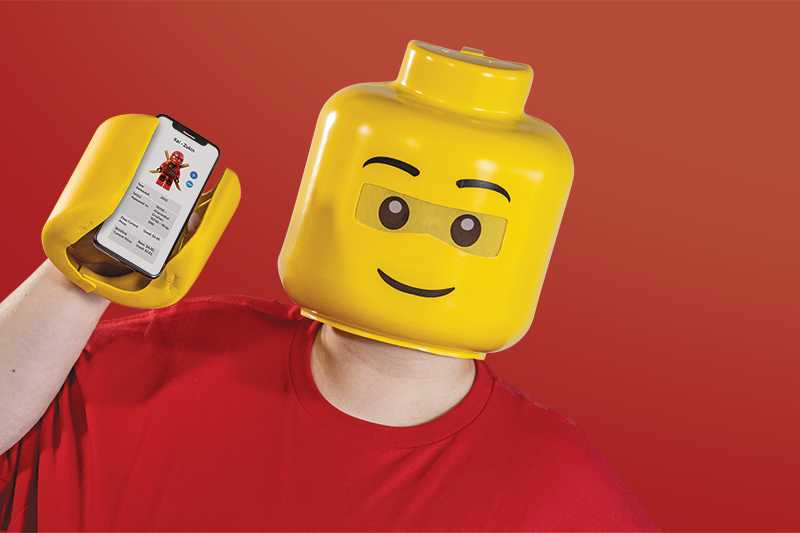
Team Member: Zack Driscoll, Game Programming
Passionate collectors know part of the fun of collecting is organizing and cataloging the collection. Collectors love LEGO and there are a variety of apps to keep track of brick sets, but for minifigure enthusiasts, cataloging systems come up short.
Zack Driscoll, Game Programming alumni, and his Student Innovation Project (SIP), The Minifig Bin, are here to save the day! The Minifig Bin is a mobile app that enables collectors to keep track of all their minifigures.
“There are plenty of times when I want to buy a LEGO set because I’m more interested in the minifigures than the build itself. It could be a set that’s marketed toward say four-year-olds, but it comes with really cool, unique minifigures, so of course, I’m going to get it; I want those characters. The minifigures are such an important part, and I wanted to really focus on them.”
Zack was introduced to LEGO early on and fondly remembers building LEGO sets with his mom and brother, who helped inspire this project. “We’ve loved it for as long as I can remember. That also bled into my love of video games because one of the first video games I can remember playing was the original LEGO Star Wars from 2005. This inspired me to become a game programmer in the first place. I feel like LEGO has always been a huge part of my life, and I’m still going to buy it today.”
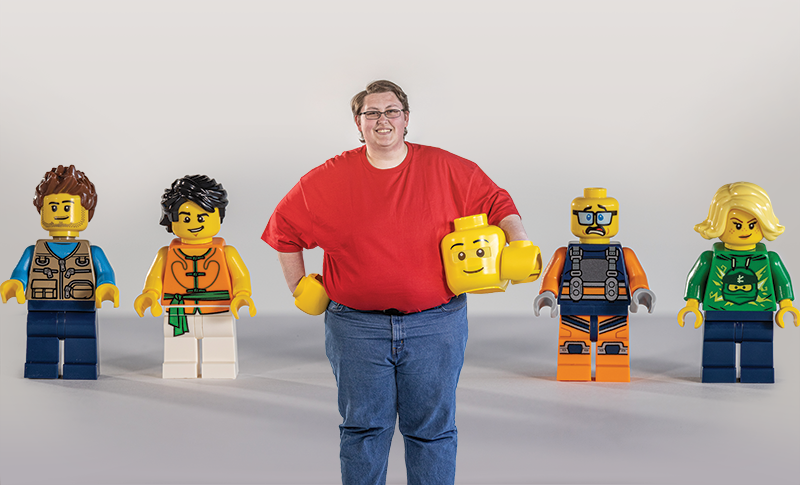
With the end goal of creating a database for every minifigure, Zack started with three LEGO themes, Harry Potter, Ninjago and Star Wars, which totaled approximately 60 different minifigures, to launch his idea from concept to interactive app. Within the app, users can add different minifigures to their profile and view pertinent collector information, such as what set the minifigure appears in and the year it was released.
The initial goal is to have LEGO’s entire minifigure collection available, but Zack also has bigger dreams for the app, stating, “Since the idea of LEGO is building, why not let people upload their own custom minifigures into the app. That’s something I definitely want to do because that’s just LEGO.”
Using Visual Studio Code as the integrated development environment (IDE), Zack built the app with React Native and JavaScript as the programming language. While there are many programming languages for apps, they typically differ by operating system. Using React Native, Zack only had to write one program in JavaScript, enabling his mobile app to run on both iSO and Android devices.
As a game programmer, many core concepts apply to app development, no matter what language is used. Plus, having already taken JavaScript courses at UAT sped up the React Native learning curve for Zack. Through UAT's React Native courses, taught by Professor Tony Hinton, Zack learned many new skills in the Expo framework for Rapid Application Development (RAD) to seamlessly create and publish React Native mobile apps.
“It is a more tedious experience than you might think, but it was definitely a lot of fun trying to make the app. I wanted to have at least two different versions of each character’s minifigure, provide some basic information and have a system to keep track of how many a collector has, which can be modified through the app.” In his free time, Zack plans to develop this project further.
Recently graduating from UAT in spring 2022, Zack reflects on his time at the University, “My favorite thing is the culture. A lot of other universities are very big, so you don’t get to know a lot of people, and you can’t always form a good connection with your professors. At UAT, you get that opportunity. I can have a casual conversation with my professors and not have to worry about booking it to the other side of campus for class. I can relax, I can talk to people. And we’re small enough where everybody knows everybody for the most part. I just really liked that about the campus experience.”
Check out the following for more information about UAT gaming degrees.
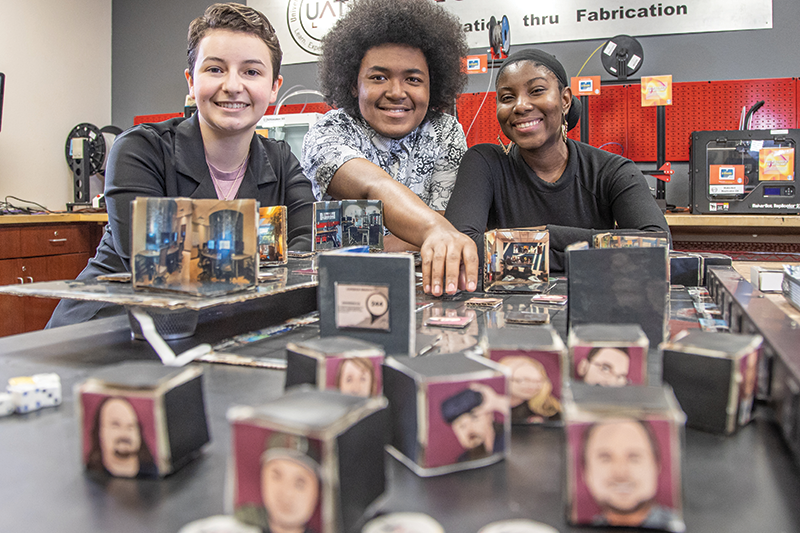
Team Members:
Christelle Cyprien, Virtual Reality
Anthony Marquez, Game Design
Morgan Soetaert, Game Design, Game Programming
Known to University of Advancing Technology (UAT) students as the paper prototyping class, Game 170 is a game design prototyping workshop taught by Professor Hue Henry. Class projects are comprised of creating five physical games (two individual and three group projects), culminating in a final project where students are tasked with combining everything previously learned in class. Students Anthony Marquez, Christelle Cyprien and Morgan Soetaert brought a showstopper to the table with their final game project, UAT Invasion.
“When it comes to skills learned in the class, Professor Hue Henry is always asking if it’s fun. He always tells you, if it’s not fun, then scrap it out, because that’s the point of games. One thing I learned in this class is to really pay attention to how my play testers are reacting to this. Are they having a dull moment, or do they want to win/is it competitive?” shares Christelle.
UAT Invasion is a two-player board game based on UAT’s campus. Taking on the role of UAT professors or evil forms of AI, players compete to take over the most territories and rooms on the board. Team Professor plays to protect the campus while team AI tries to hack and take over control of the school with the end goal being the first player to control four of the seven rooms wins.
Starting the game in designated spots, each participant plays with three character markers that can move in any direction across the board, aside from diagonal. Focused on tactics, strategy, chance and skill, the game is played with movement cards and dice, and includes bonuses such as blocking, puzzles and special abilities.

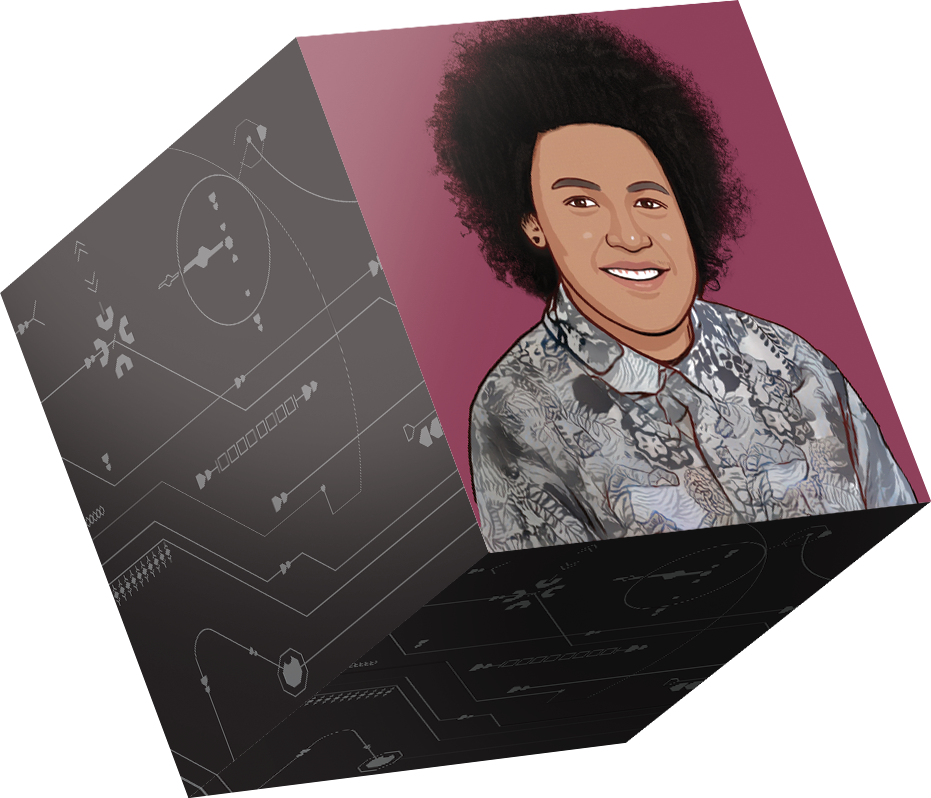

Characters are classified as Programmers, Designers, Artists and Math Experts, and include many well-known faces around UAT. Play as Professors Derric Clark, Heather Peters and Matthew Marquit, to name a few, or the Monitor, Drone and Phone, and unlock special abilities depending on the chosen characters.
Special Abilities
To earn special single use abilities, land on a matching player square and complete the puzzle. Designers unlock the ability for a player to move twice with the option to either move one character twice or move two characters once during that turn. Players will use a separate movement card each time. The Math Experts enable a player to change a die’s value. They can add a point to one of their dice or remove one from an enemy’s die. Programmers unlock the ability to roll a die twice when a player is attempting to capture a room. Artists enable players to shuffle the deck and swap their cards for new ones.
UAT Invasion also includes a special room on the second floor of the board for Provost Dr. Dave Bolman, which has different rules from the other six rooms. At the start of the game, both players roll two dice to establish the number required to control this room. The dice are left in the room with a player marker. When a player reaches this room, they have 30 seconds to roll the predetermined number to win this room. If successful, the player will control this room for the rest of the game; the other player cannot steal this room. If they fail, the player can try again during their next turn.
When asked about her experience at UAT so far, team member Morgan Soetaert states, “I love it here. I love the environment. The people are just unique. We’re all very similar, you can talk to anyone and immediately have a related interest. The professors are helpful, and they really care about your education. I enjoy talking to all of them—they’re all very passionate.”
Team member Anthony Marquez shares a similar perspective, “My experience here has been really great. It’s not hard, but it’s not easy. You learn a lot because it’s really hands-on, and the teachers are cool because they’re just older versions of us. The people here [are my favorite], you can talk to anyone because they’re interested in the same things, you don’t feel left out here.”
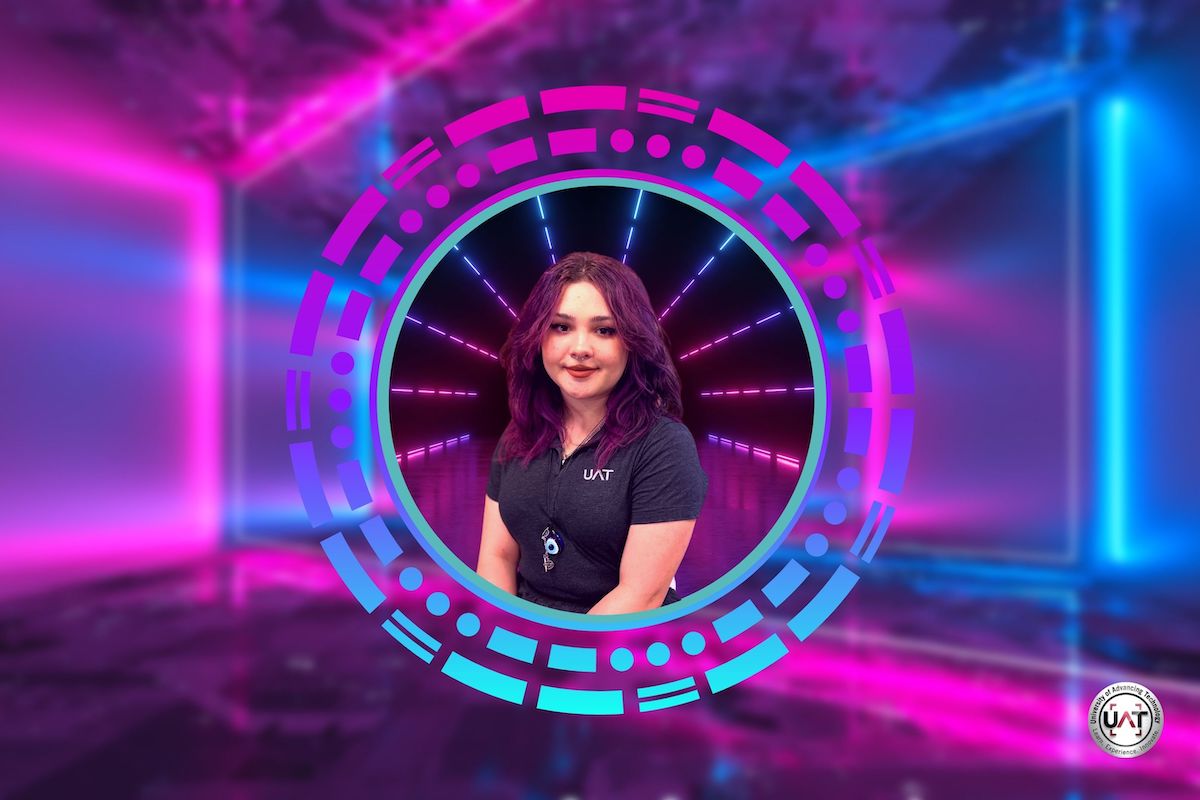
University of Advancing Technology (UAT) sat down with Student Ambassador, Katherine (Kat) Ervin to talk about her studies and how they intersect with her work and personal life.
"Going into this field has made me happier than I ever have been, and I truly get to let my passion and personality shine in my work." - Katherine Ervin
What Is your major and why did you choose it?
I am majoring in Game Design and Game Art and Animation. I have always been passionate about art and video games. I wanted to find a career path that incorporated the two and I found out that being a Game Artist and Designer wasn’t “the guy in his parent’s basement” like everyone said but was an actual job! Going into this field has made me happier than I ever have been, and I truly get to let my passion and personality shine in my work.
How many credits are you taking this semester?
I have five classes and each class is around three credits. Next semester, however, I want to turn up the heat and take seven classes in total.
Why did you want or have to work while earning your degree?
I wanted to work because I would like to be able to have more income for my projects and to help my mother out. She is a single parent and must take care of my little brother, who is still in high school and is special needs. She would send me close to a hundred dollars a week and I would feel terrible because we never had much, and I want that money to go towards my brother and the home we live in. I also needed extra money on the side for the software that I use personally, and I hated when she had to pay for it. Now I pay for it on my own and I alleviate her of having to spend extra money weekly.
Is it challenging to work while attending school?
It can get challenging sometimes. I sometimes have a hard time with time management and procrastinating on my schoolwork. Once I get behind, it gets hard to balance the incoming work along with the late assignments and then go to work on top of it. However, having the job has given me a sense of responsibility and has helped me procrastinate less. So, in all honesty, it has helped me stay stable in my grades more than drown me!
How are you working through it?
I am doing my work earlier and on days I am off, so I do not have to worry about it. If I have a late assignment, I do the work that’s recently due first so that is not late, and then I focus on each class and do the late assignments after.
What other time or monetary responsibilities outside of work and school do you have?
Outside of work I am the president of UAT’s Art Club. Other than that, I do not have much more besides my various hobbies. I draw, I play videogames, I make videogames (for fun) and I also spend a lot of time with my friends going to new places and experiencing new things.
Financially, how does working as a Student Ambassador support your life?
Working as a SA has helped a lot financially. I am now able to spend money where I need it and have leftovers to drop into my savings! It makes my personal life and responsibilities much more manageable.
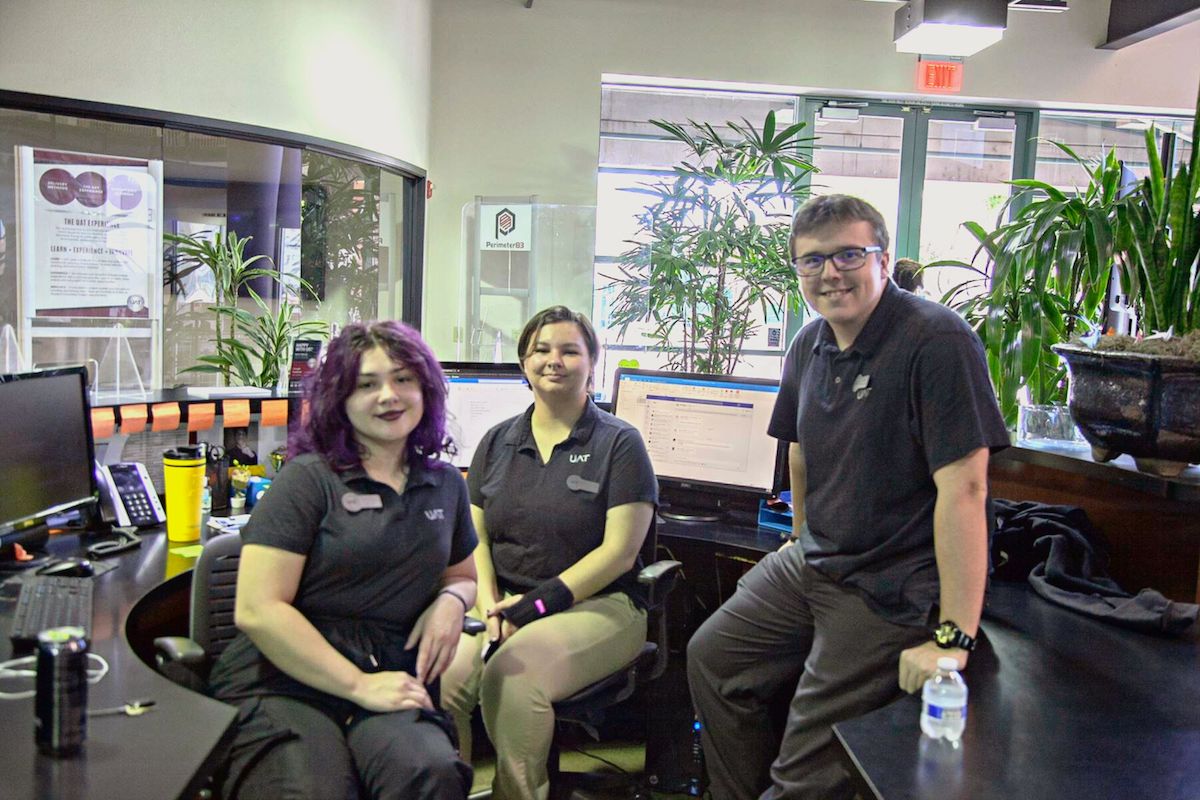
Katherine working UATx with her friends and fellow Student Ambassadors, Skylar and Hunter.
Why did you want to work on campus instead of elsewhere?
My friend, Hunter, pushed me to get this job. At first, I was unsure because I did not think I would be a good fit as a SA, especially since at the time my grades were low, and I was struggling to keep my head above water. I thought about opening my commissions again, and just selling my art, but I knew it wouldn’t get me where I wanted to be financially. So, I looked into it more and I liked the idea of interacting with potential students and helping them along their journey to UAT. So, I took the interview and Ta-da! I am here now with a job I thoroughly enjoy doing!
What is the best part about being a Student Ambassador?
Honestly, I like giving tours. I know I just got tour approved not long ago, but I love meeting new people and talking to them about their interests, showing them things that might interest them and showing off places around the campus I enjoy!
How do you stay on top of schoolwork?
I like to do my work on the days I am off and before they are due. If I do it this way, then I do not have to worry about coming home from work and needing to do project work on top of it.

Do you have any free time for other hobbies?
All the time! I constantly take time for myself to play video games, hang out with friends and just kick back and relax! I play video games most of the time since it is something that brings me a lot of peace and happiness. I truly feel at home when I can play games. Right now, I am currently playing the game “Hades” during my free time!
How does working while earning your degree help someone get where they want to go over if you were just working?
I feel like working anywhere at any time will give you a good experience, even if it’s not in your work field. You can learn valuable workplace skills like communication, teamwork, and management solutions. I believe being an SA is good for me because I can work on my social skills! It’s like a bonus when working while getting a degree, so not only are you gaining real-life skills but also the skills of your trade on top of it!
Where do you see yourself in ten years?
I can only hope that in ten years I am doing what I love. I hope I am working on or have made a game that I am proud of and that many others can enjoy. Games have always given me a sense of release and happiness, so I hope in ten more years I can give many others that same sense of happiness.
What advice do you have for a prospective student who is concerned about balancing school with their work and other responsibilities?
I know this may sound crazy but just go for it! If you truly want it, then adapting to the new schedule of work and school will be like second nature. Just make sure to keep your chin high, work done on time, and give yourself the time to relax and have peace in your day-to-day life.
Looking for a student job? Check out the on-campus jobs available to students at UAT.
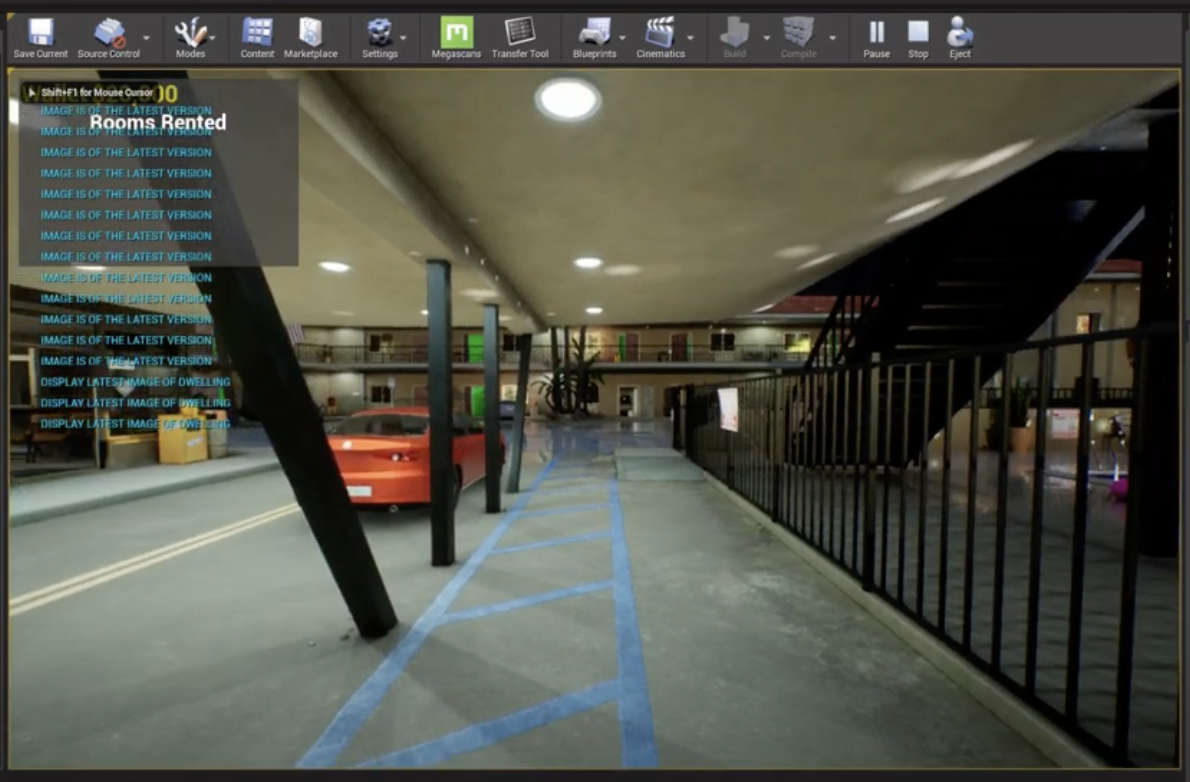
For students at the University of Advancing Technology (UAT), completing their Student Innovation Project (SIP) is the culmination of their hard work and dedication to their degree program. These projects are not only exciting for the students, but also to their professors who witness their progression and development.
One such SIP is Mark Montenieri's Updatable Interior Mapping project. According to Professor Hue Henry, "It is a brilliant use of a cutting-edge technology to solve the problem of how to provide one of the most heavily-requested features in the MMORPG genre."
Professor Henry continued, "The use of cubemaps as a way to display interior spaces is a relatively new innovation in the game industry. Mark's project takes that to the next level by applying it to user-created spaces, such a player housing in a massively multiplayer online role-playing game (MMORPG). However, these features are often prohibitively expensive. Mark's innovation makes it possible for many thousands, even millions of players to decorate and display their in-game homes in a way that is feasible with current MMO technologies and bandwidth limitations."
Read on to learn about how Mark arrived at the idea and his future plans.
What is the purpose of your SIP and your claim to innovation?
My SIP aims to make in-game cities and towns appear more alive by offering updatable images instead of static pictures on storefront windows and doorways. It also benefits densely packed player housing, such as an apartment building, by removing the actual housing to another part of the map and only showing recently updated images overlaid on windows and open doorways. Players would approach the doorways and enter the associated room or apartment via a portal method, which teleports them to the actual room, far away. This helps game performance by only rendering the room for players inside it and not to everyone who walks by. Anyone who’s played a multiplayer game and entered an extremely busy arena or town has experienced lag from the game having to render the space for every player simultaneously and my SIP aims to improve that aspect of multiplayer gaming.
Watch his final presentation:
What inspired your project?
My wife and I used to play a game called Ultima Online (late 90s?), and we loved the player housing feature. As the game fell out of favor and changed to the point it was unrecognizable, we moved on, looking for a new game to play that still offered great player housing. Here we are, 20 years later and still haven’t found what we’re looking for, so I wanted to come up with an idea that would allow game-makers to offer housing while keeping lag to a minimum, since the number of people playing online games has skyrocketed.
What part of your SIP are you most proud of?
The fact that this has never been done at scale in an MMO, at least to my knowledge, is what I’m most proud of and hope it’s something that may be incorporated into a shipping game one day.
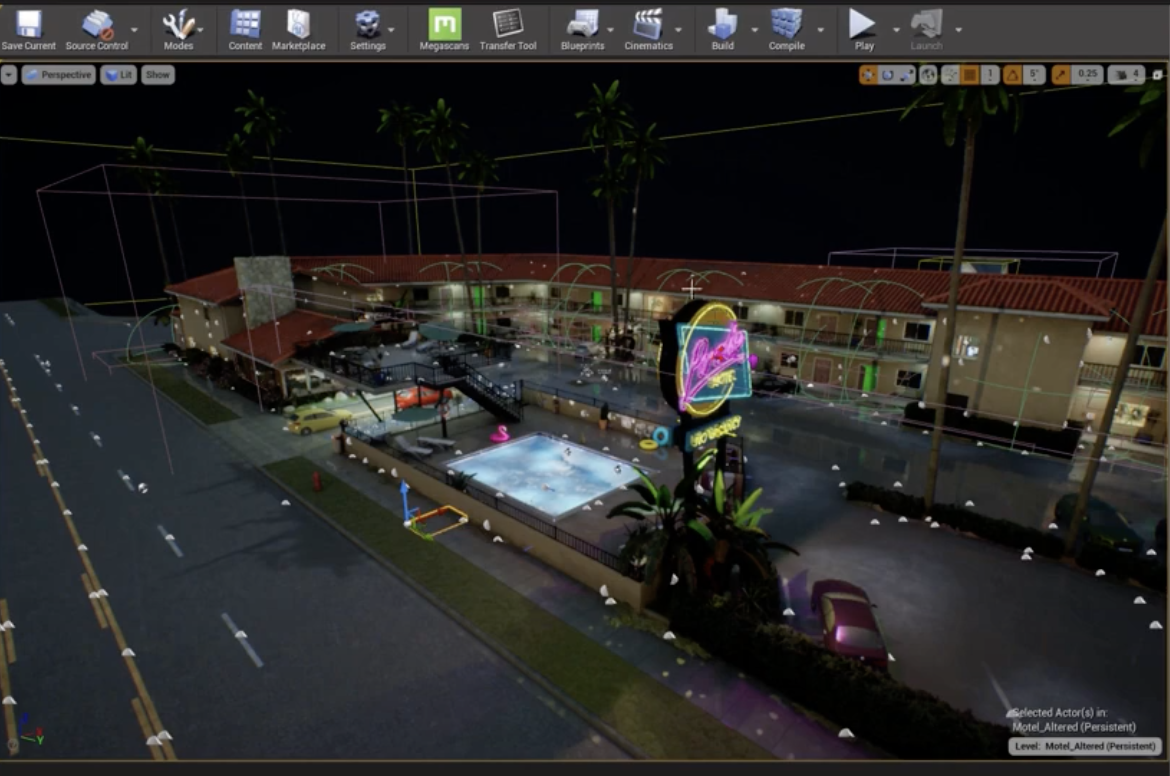
What parts have been difficult and how did you solve the problems?
I suppose the most difficult part is that my SIP uses the Unreal Engine. Since I started using/learning Unreal in 2017, I’ve been what I call a ‘Hobby-level programmer’, never rising to the point where I felt comfortable calling myself a game programmer. Learning Unreal Engine is difficult because it’s so complex, but being a student at UAT and having used the engine in multiple classes to create complete or near-complete games has helped my confidence and increased my proficiency quite a bit.
What are your future plans for the project?
For now, I’ll be sitting on the idea while I work on a larger project but may incorporate it as a feature before I ship. If it turns out that it’s not a good fit, I may create my own game that utilizes my SIP concept.
What are your plans after graduation?
Ah, the million-dollar question. Honestly, I’m not sure where my path leads, but having degree in hand should surely open doors previously unavailable to me. I look forward to exploring options and opportunities once my journey at UAT is complete.
Mark is graduating with his Bachelor Degree in Game Programming in Fall 2022. We're excited to see where he lands and his continued innovation after he leaves UAT!
Considering a career in gaming? Check out the following for more information about UAT gaming degrees.

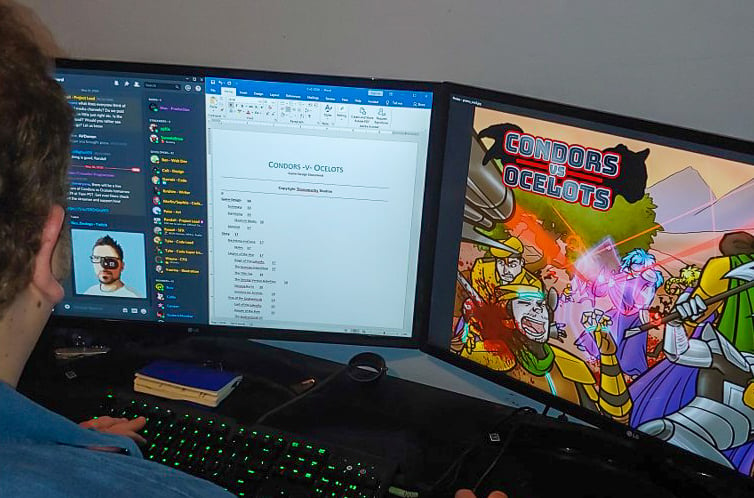
When students leave UAT, they typically aren't heading out to search for an entry-level opportunity. Our grads have invested their time here creating and innovating (on their own and through internships) to such a degree that a great job or entrepreneurship venture is a natural next step.
Such is true for Randall Tatum, UAT alumni and Founder & CEO of Titanomachy Studios, LLC. Randall is an excellent example of how our students take what they learn and really go for it in the "real world". With a Bachelor’s of Art Game Design as well as a Master of Science in Production Management, Randall is not only achieving his dream, he is also helping others by advocating for independent developers in the game industry.
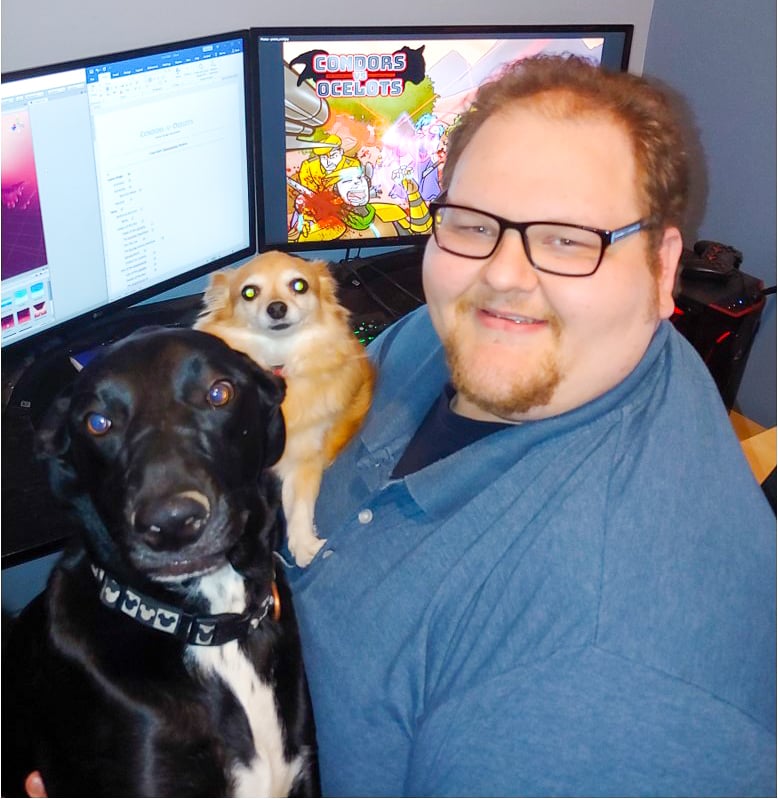
Randall Tatum, CEO of Titanomachy Studios
We caught up with Randall to ask what it's like owning his gaming company, plus to find out why he feels getting an education in an often do-it-yourself field helped him get to where he is now.
Titanomachy Studios is a fully remote indie studio based out of Avondale, AZ and Stroudsburg, PA but with a team from around the globe. We are made up of people from all walks of life and backgrounds from Canadian pixel artists to English writers to UAT alumni programmers. We focus on creating game development. Our focuses are creating our own titles, like the upcoming SRPG, Condors Vs Ocelots, and Indie Publishing. We strive to make games that are fun and memorable experiences for everyone.
Titanomachy Studios has a very diverse team from all walks of life and experiences. From the top: Ben S. – Web Developer; Tyler S. – Programming Lead; Tyler T. – Programming; Garrett H. – Programming; Merlin C. – Programming; Hunter D. – Programming; Michael M. – Art Lead; Alethea H. – Artist; Peter G. – Artist; Yoorina S. – Artist; Ibrahim A. – Writer; Max S. – Assoc. Producer/Game Design; Jeremiah B. – Level Design; Colt B. – Level Design; Box Monkey Studios – Audio and SFX; Wayne D. – Finance/Legal; Randall T. – Project Lead/Producer
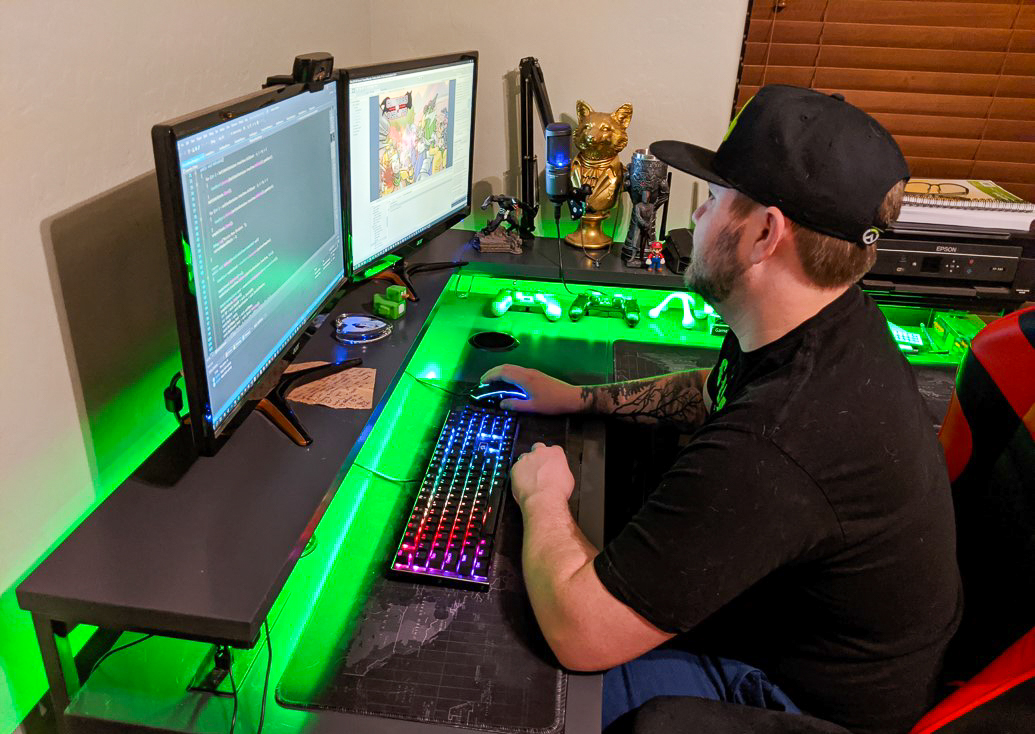
Hunter Derrick, Programmer at Titanomachy Studios
My education has simply enabled me to not only think in new ways, but also to give me a baseline on how things should or should not go based on my resources and effort. I used my degree to work in the field, but it wasn’t until I pursued my Master’s at UAT that I began to think about disrupting markets and being an entrepreneur and really just making my own path instead of following others. If it was not for the things I learned in my education, I would have been sorely prepared and educated on how to start and operate a business.
I think that, an education is important for many reasons. Obviously the technical instruction in your desired field is possible, but more than that, learning new ways to think about and solve problems and situations has helped me immensely. Videogames, like any other technical field, is just that--technical. Having an education not only facilitates learning new ways of thinking, but it also instructs on at the very least the basics, so that doing your own skill polishing and “leveling up” is possible.
A degree in the game industry is important for the same reasons a degree in the medical field is necessary. Not to say that making video games is on par with saving lives; however, I certainly wouldn’t hire a career plumber to be my lead game designer when his education is in plumbing. It applies here. When I interview people to work with us at Titanomachy, a degree doesn’t get you the job. Merit does, however, when two applicants are equal, the game degree wins out in most cases. I know that that person is instructed and SHOULD know what I’m saying when I say it.
If you have a dream, follow it. No one is waiting for you to pursue them so follow your heart and use your head to navigate. Otherwise, stay organized. School is hard work and preparedness cannot be underrated.
Your portfolio is the single most useful thing you can offer any place you apply to. Make it big, make it varied and make it good.
Five years ago, we released our first ever title, Stacker. It was an abysmal mess of spaghetti code and disorganization. It was also the proudest moment of my career, because I had a dream, I took the steps, and I achieved it. That feeling is irreplaceable.
I had a dream, I took the steps, and I achieved it. That feeling is irreplaceable.
We started out remote, if for no other reason than to keep our overhead costs down. There are a lot of learning curves and communication barriers that are easy to forget, but critical issues arise from them often. There was a learning curve that I think would give most people a shiver or two, but after 5 years, when Covid came around, we were ready to stay safe, healthy and developing.
![]()
Michael Monchamp, ORU lead sprite artist at Titanomachy Studios
I am biased here because I think Condors Vs Ocelots is my favorite, but I have been enjoying Terraria, Legends of Runeterra, and Valorant.
I think what I look for the most in games is a compelling story and interesting mechanics. I come for the narrative, but stay for the awesome gameplay.
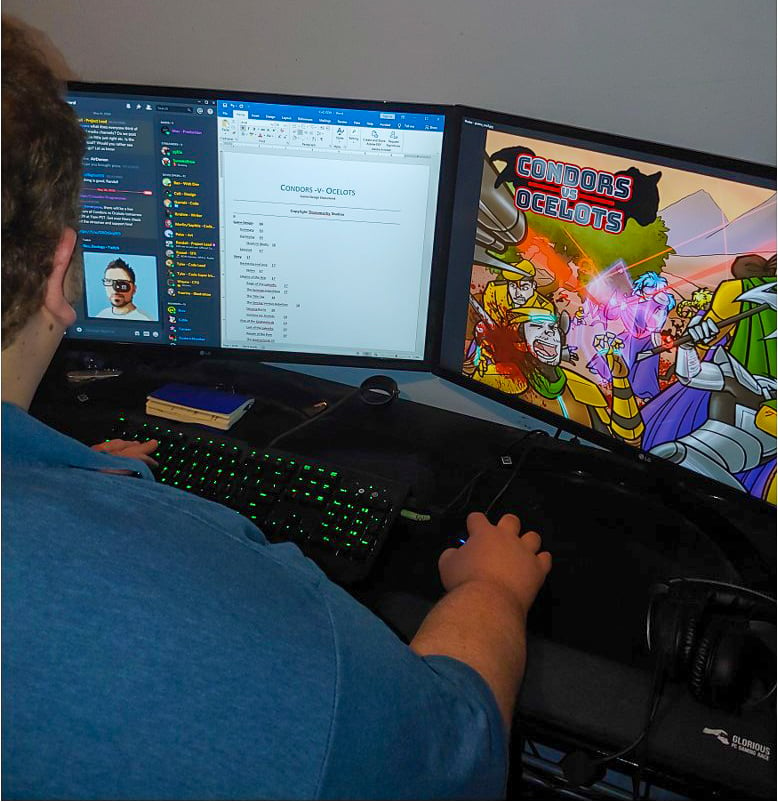
To find out more about Randall and Titanomachy Studios, visit their Facebook and Twitter.
Thank you Randall for your inspirational words! If you are a student or alumi and would like to share more about your experience, comment and let us know!
Want to know more about our Game Studies Degrees? Email admissions@uat.edu to get started!
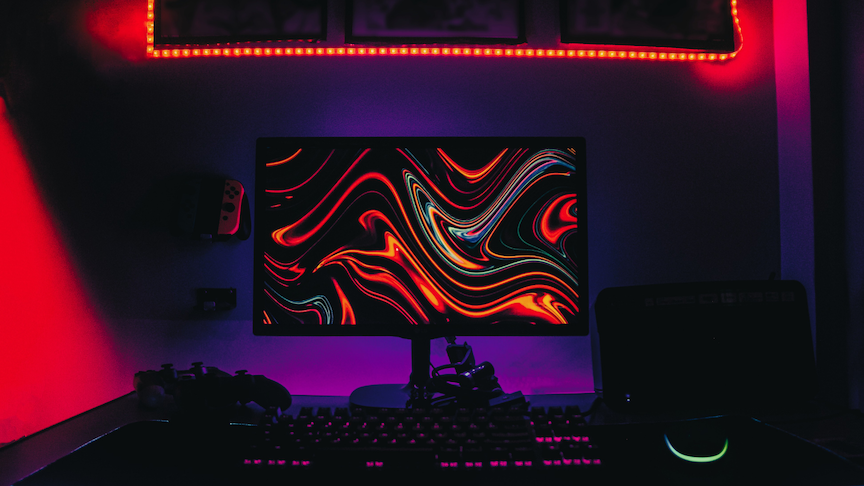
Organized by Adam Moore, the jammers used Discord to communicate, form teams, and help each other out. The 2022 theme was Duality, with 16 games uploaded to UAT’s jam site at https://globalgamejam.org/2022/jam-sites/university-advancing-technology/games.
The Global Game Jam concluded on Sunday, January 30, at 3:00 p.m. Arizona time. Wrap-up included presentations and awards, followed by streaming the games on Discord.
The following are UAT’s site winners:
Best Design: Mirror Block
https://globalgamejam.org/2022/games/mirror-block-6
Credits:
Game Programmers: Darin Palermo, Lyndsey Boggs
Game Artists: Kaulana Lee, Lyndsey Boggs
Game Designer: Darin Palermo, Lyndsey Boggs, Kaulana Lee, Raul Montes
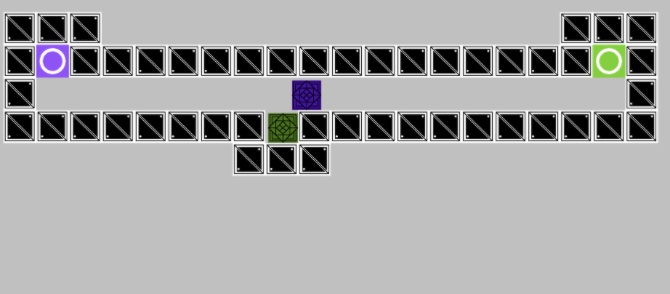
Best Art: Harm Charm
https://globalgamejam.org/2022/games/harm-charm-6
Credits:
Art by Morgan Kitay and Nick Campbell
Design and Programming by Jeremy Johnston
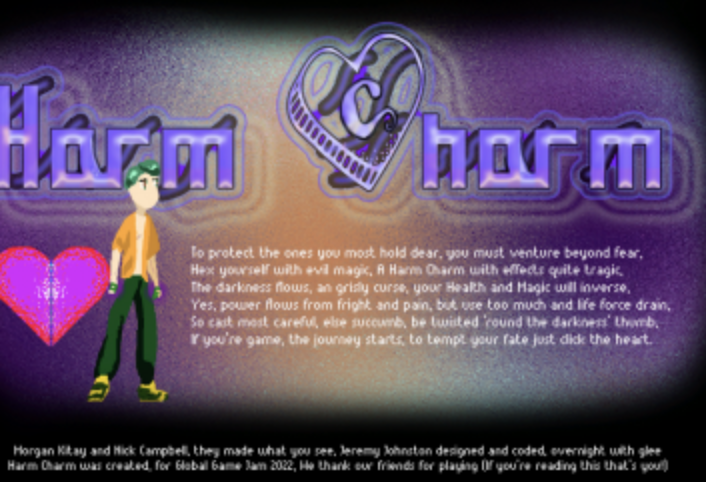
Best Technical: Polarity
https://globalgamejam.org/2022/games/polarity-6
Credits:
Made by CatWithAKeyboard in less than 24h
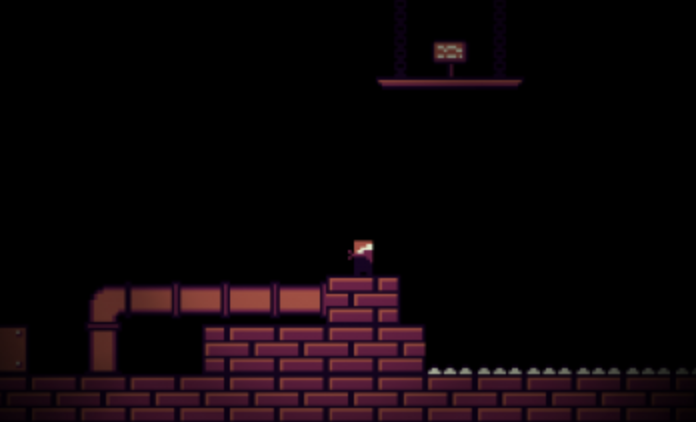
Best Audio: NoThinkingThing
https://globalgamejam.org/2022/games/nothinkingthing-3
Credits:
Development and Production credits to William Bailey and Wyvern Studios and Entertainment, LLC.
Art contributions made possible by Epic Games and Wyvern Studios and Entertainment, LLC.
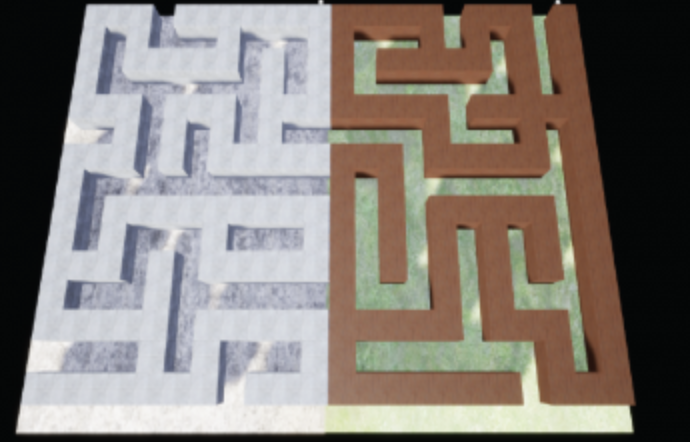
Weirdest Game: A Shadow Named Nyct
https://globalgamejam.org/2022/games/shadow-named-nyct-4
Credits:
Music, Art, and Code by Carter Brinkley

Great work to all of the jammers! And remember, you don’t need any experience to participate in these events. Be on the lookout for the next opportunity to join the fun—and games!
Considering a career in gaming? Check out the following for more information about UAT gaming degrees.


On Saturday, November 6, 2021, UAT students and faculty participated in ExtraLife—a streaming fundraiser benefitting the Children's Miracle Network Hospitals. The UAT team was hosted by Professor Derric Clark, team captain in his third year of participation in ExtraLife. Gamers were able to stream as long or as little as they chose starting at 8:00 a.m. the day of the event, and although they individually raised the funds, they all worked together as one UAT team.
A total of 29 streamers signed up for the UAT ExtraLife team; 11 of those received at least one donation. According to Professor Clark, a total of 17 UAT streams were happening at one point or another, “A couple of those were a group, so 25-30 total people participated!”
Although the excitement of the weekend has ended, the fundraising actually continues through the end of the year. The UAT team already reached their goal of $2,700 on November 9—so the team has decided to carry on—raising their target donation to $2,900 for the Children’s Miracle Network and planning to stream again over Thanksgiving weekend.
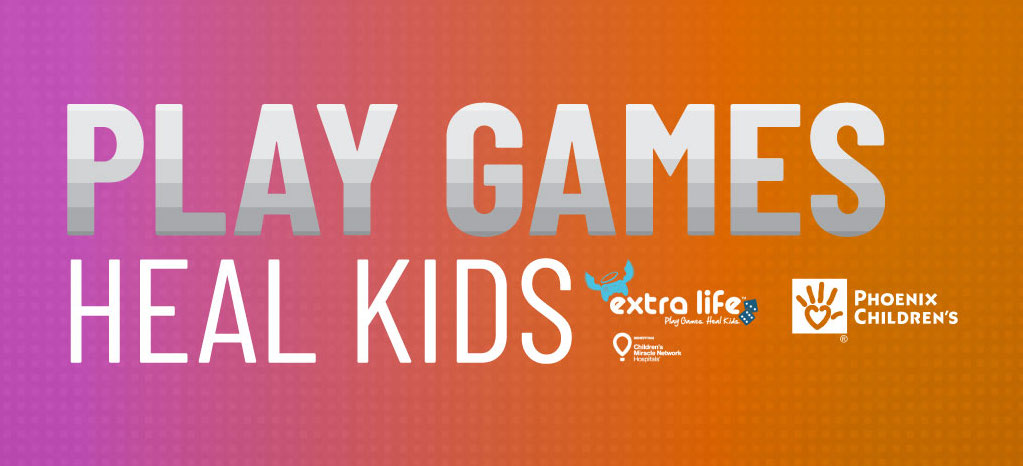
“The students did an amazing job, and I cannot thank them enough for being a part of this event and supporting a great cause,” said Professor Clark. “I would also like to thank everyone for your support on all fronts; you made a difference in the lives of others!”
And for the students, the experience was good for both their education and character. According to streamer Taylor McKenzie, “The pressure of the stream is what I needed to keep me moving forward with my game development; it really helped! Receiving the donations and knowing they were going to a great cause also felt incredible and streaming for charity is moving its way into my schedule regularly. A push for my own motivation and helping others at the same time, why wouldn't I keep going?!”
Student Wren Martin also greatly enjoyed the event. “I truly felt honored to be a part of this experience,” they said. “As a content creator myself, my goal is to entertain, give people a reason to smile, and to help others who are in need. One of my goals has always been to participate in a fundraiser to raise money for charity by doing what I love—gaming. My goal was accomplished, my dream came true, and I am thankful for the experience that I had. I will 100% be doing this again.”
UAT is very proud of Professor Clark and the students who put their talents to use for this great cause. View the UAT team page at https://www.extra-life.org/index.cfm?fuseaction=donordrive.team&teamID=58496. There you can join the team, watch the streams, and make donations. Happy streaming!
Name: Derric Clark
Online Name: Deconstruction Gaming
Channel Link: https://www.youtube.com/DeconstructionGaming/
Thought on the experience: It was great being part of a group willing to put time and effort into helping others. Jumping into all of your individual streams and watching you play and interact was amazing.
Name: Trevor Baughn
Online Name: TheGoatIsBetter
Channel Link: https://www.twitch.tv/thegoatisbetter
It was hectic, but really fun. Lots of fun jokes thrown between Boone and myself throughout our stream. We had a fairly consistent viewer-count too, so that was nice. If Boone is willing to come on with me for another sometime, I'd be hella down.
Name: Jordan Dunaway
Online Name: Dunaco
Channel Link: https://www.twitch.tv/Dunaco
I'm just doing what I do, why not stream it too.
Name: Jozlyn Nowak
Online Name: Luna748
Channel Link: https://www.twitch.tv/luna748
It was a lot of fun. I had run the Esports channel for most of the day and ran some on my own. It was a lot of fun, everything I had set up for The Wyverns and being able to promote a charity. I’ve been streaming for 4 years now and it’s nice that I've finally been able to do a charity event, I had been wanting to do one for a while.
Name: Joe Parisia
Online Name: Gorgonak
Channel Link: https://www.twitch.tv/gorgonak
It was fun! I wanted to start streaming for just that reason and I've always loved helping charities in the past. Combining them both together is that much better.
Name: Ryland Kealey
Online Name: Jazz Boy
Channel Link: https://www.youtube.com/channel/UC2EBr2SGtYfSnwCVKj4yDqQ
Super fun! loved playing Minecraft and making pixel art on stream! I can't wait to do this again some time!
Name: Ibrahim Al-Nassir
Online Name: Ian A. Narcisse (or Ian_NYC)
Channel Link: https://www.twitch.tv/ian_nyc
I had a fun time learning to stream on a new platform. It was also the first time I had to come up with things to do. It introduced me to a new way to practice 3D modeling, and that was especially fun.
Name: Taylor McKenzie
Online Name: Blubehriluv
Channel Link: https://www.twitch.tv/blubehriluv
I had a great time hanging out with folks and just speaking out loud the way I normally do in my head. The pressure of the stream is what I needed to keep me moving forward with my game development; it really helped! Receiving the donations and knowing they were going to a great cause also felt incredible and streaming for charity is moving its way into my schedule regularly. A push for my own motivation and helping others at the same time, why wouldn't I keep going?!
Name: Emily Szymanski
Online Name: Hok-Z
Channel Link: https://www.twitch.tv/hokzii
The team did wonderfully even though I severely miscalculated the time it would take—that's on me. They saw it through to the end and I wouldn't mind bringing them through another raid at some point. There's a possibility of that being streamed, too. Overall, a super fun experience.
Name: Wren Martin
Online Name: Reddbirb or ReddbirbLive
Channel Link: https://www.twitch.tv/ReddbirbLive
I truly felt honored to be a part of this experience. As a content creator myself, my goal is to entertain, give people a reason to smile, and to help others who are in need. One of my goals has always been to participate in a fundraiser to raise money for charity by doing what I love—gaming. My goal was accomplished, my dream came true, and I am thankful for the experience that I had. I will 100% be doing this again.
Name: Donavan Potter
Online Name: HunterofOil
Channel Link: https://www.twitch.tv/HunterofOil/
I enjoyed the experience and enjoyed being given the opportunity to take part in helping a cause that was larger than myself. I started without a cash goal in mind, but simply wanted to bring awareness and raise as much from any charitable individuals who wanted to donate and have no problems doing this event again.


Retro gaming can be seen in a couple of different ways. The core of retro gaming is playing older games or games from a previous generation (human or console). So, what is the allure of retro gaming?
It starts out with nostalgia. It is common for people to long for the days of their youth as they grow into adulthood, or even pick up things they wanted but didn’t have as part of their childhood. The same can be said for other parts of adult life, such as the collector car market. There can be a bubble in collector cars that is about 30 years old, as these are the cars people remember that they have wanted or had in their younger days. Harkening back to a simpler, fun time with less responsibility has an appeal as well as an escapism quality.
As game technology moves forward, the older systems quit getting produced. While they are still available on eBay or Craig’s List, they are no longer being manufactured. This does create a scarcity in the market for original equipment. While game companies are now seeing this and release retro versions of hardware, compilation versions, and remakes of classic games, many want the feel of the original as part of the play experience. It is similar to those who like the feel of a book over a Kindle; for some, this improves the experience and the same can be said for these classic consoles, controllers, and games.
What games and hardware are the most important as an historic and personal side? From a personal perspective, the must-have system will be the one you grew up on. It may not be the best or most relevant, but it is the one that captures your heart. On the historic side, you have two things to consider.
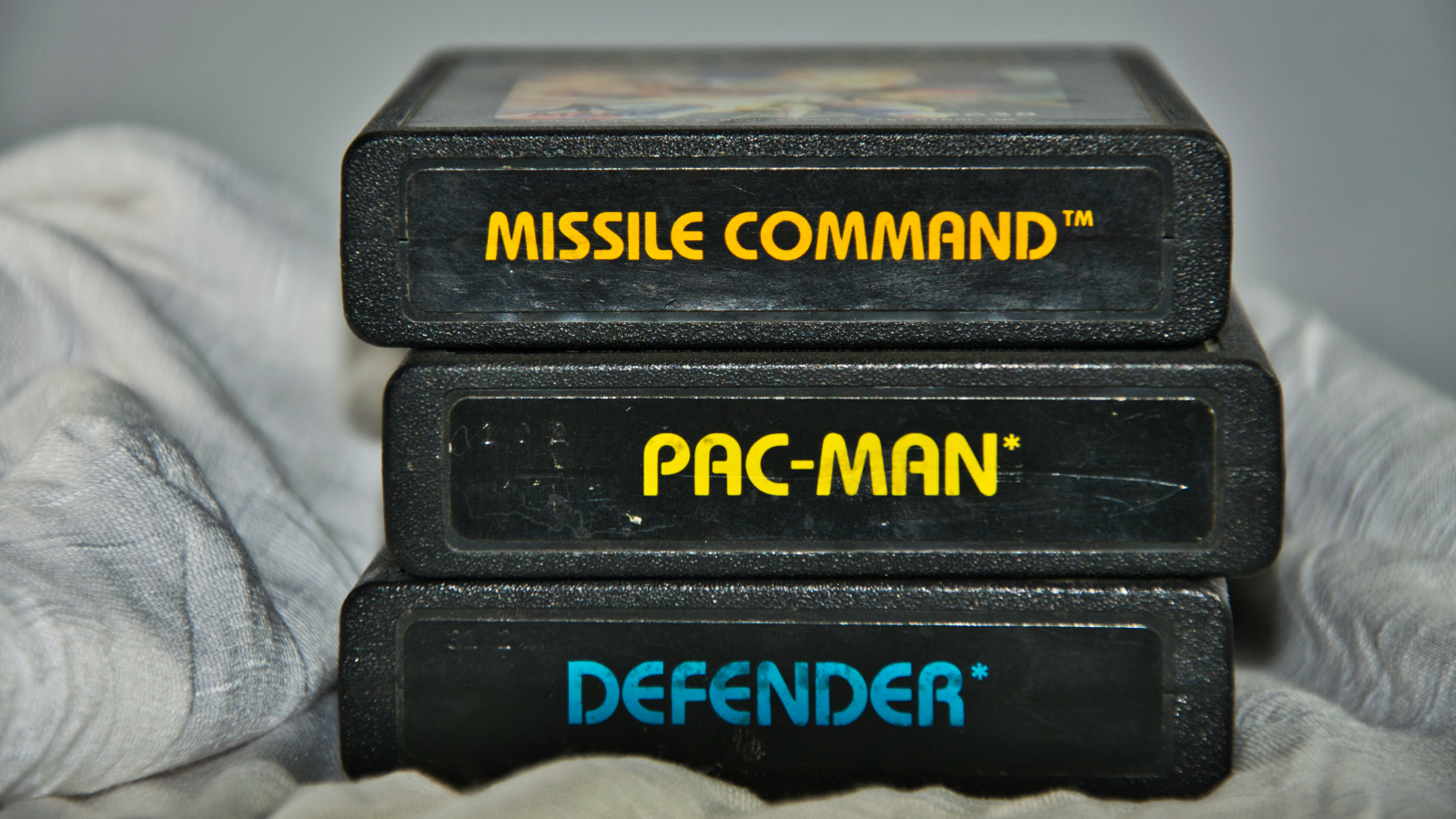
First, there will be a group that likes to collect the odd ball or rare systems that exist. The Virtua Boy, the Power Glove, Sega Dreamcast or Saturn, Game Genies, or Atari Jaguar, to name a few, were not the best or most relevant but have a quirkiness that attracts collectors and players.
Second, from an historic standpoint, there are systems that helped define the industry. The Atari VCS (2600), the original NES (Nintendo Entertainment System) with R.O.B., the Game Boy, the Sega Genesis, the PlayStation and PlayStation 2, and the original Xbox all can make a case as being industry and culturally relevant.
In the end, can you put a price on memories? Can you deny your inner child? Can you deny the future generation the core, great game experiences that still hold up in these older games and consoles? Good games are good games, and finding ways to keep them alive is good for gaming, good for gamers, and good for the future of the industry.
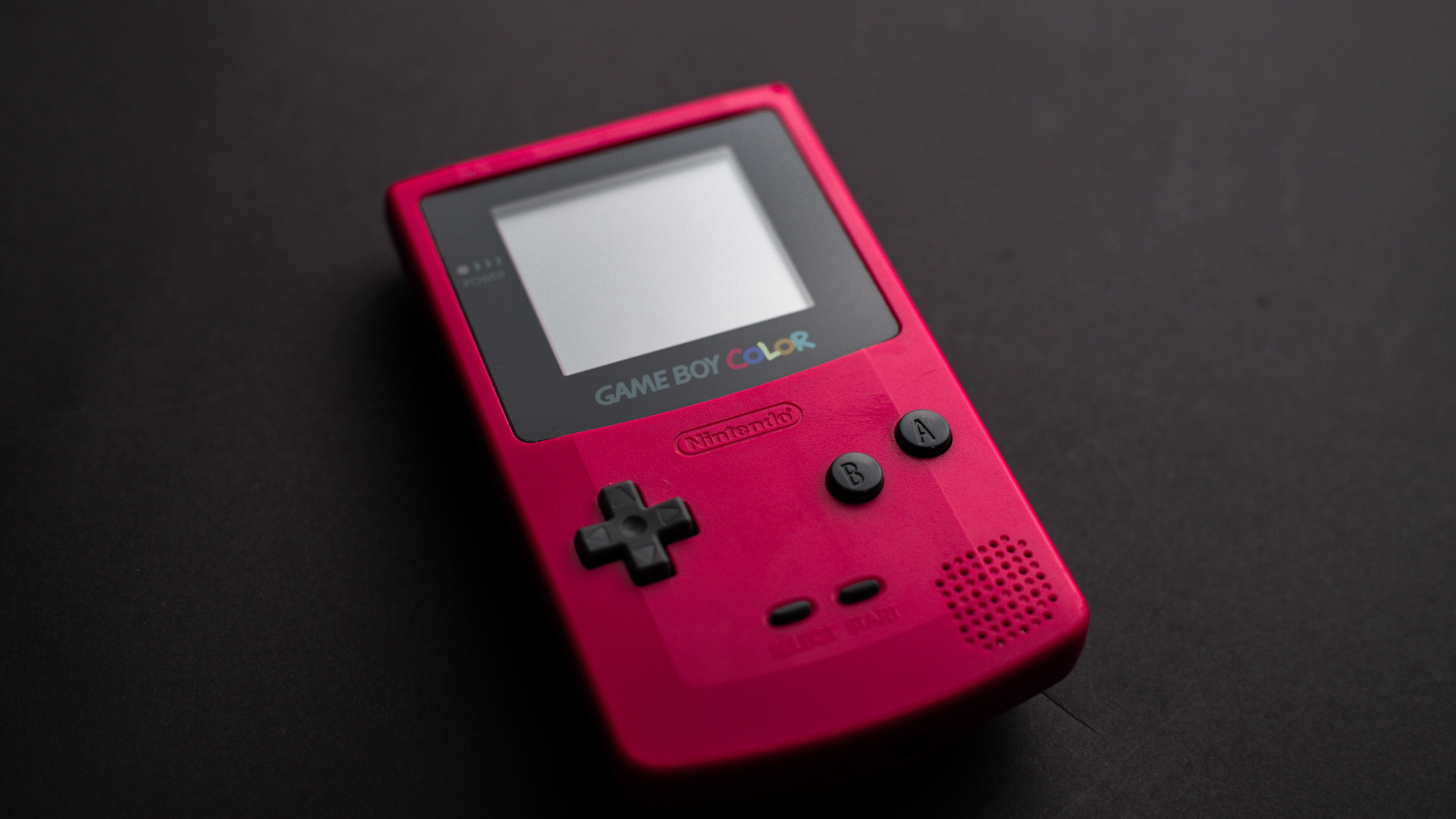
Considering a career in gaming? Check out the following for more information about UAT gaming degrees.
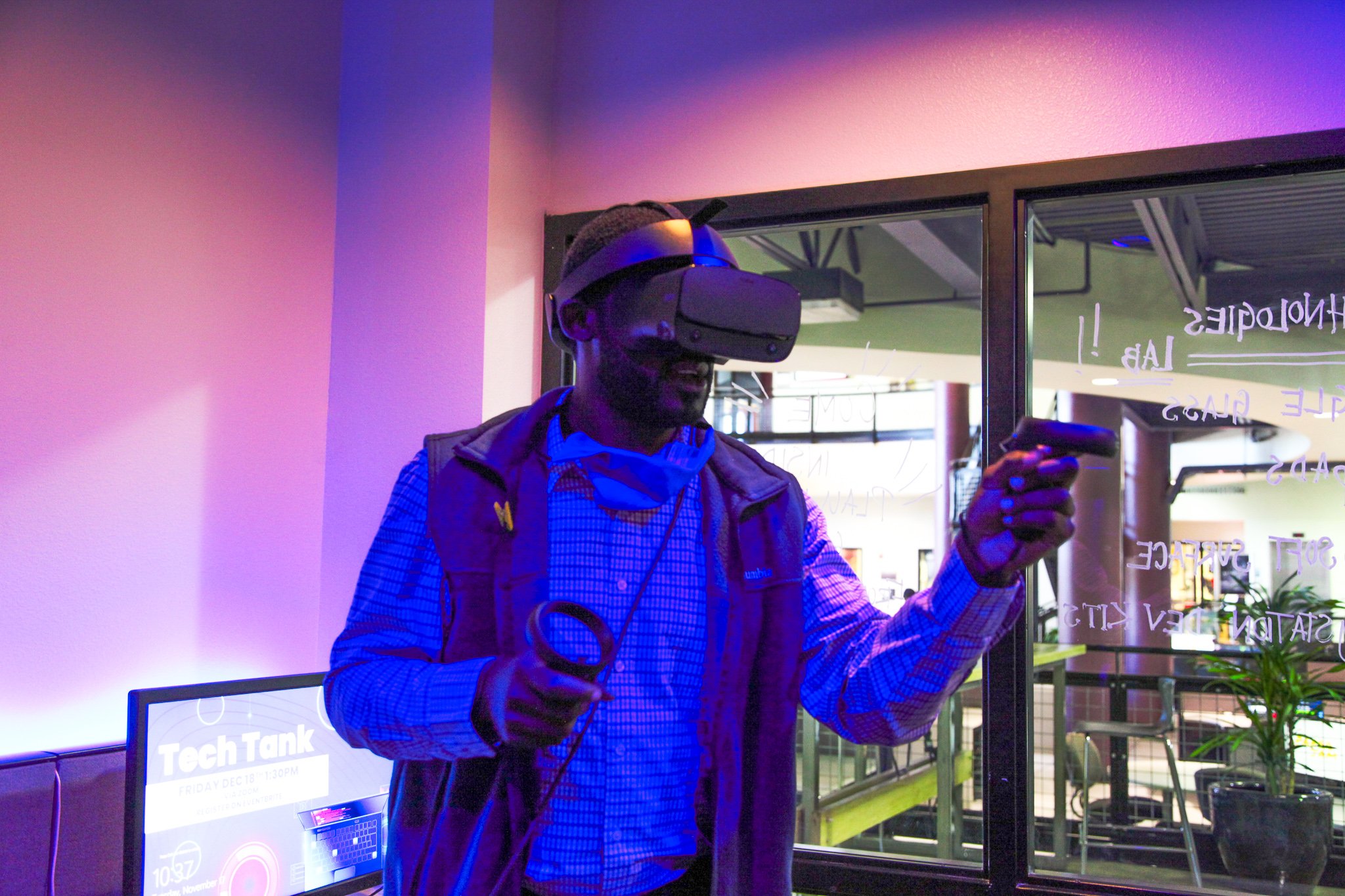
If you often find yourself daydreaming about fantasy worlds, diving into the digital depths of mystical lands, or engineering complex landscapes in your favorite games, then game design may be the career for you.
Gaming allows you to explore a limitless world of possibilities – both in terms of career potential and in exploring what’s possible in today’s digital frontier. You are able to explore your own creative potential and cultivate a lucrative, fulfilling career. At University of Advancing Technology (UAT), we open the door to gaming and design aficionados alike.
Gaming is one of the most rewarding careers out there. While it can be challenging, the career outlook is good, with the job market expected to grow by 8% between 2016 and 2026.
The gaming industry as a whole has seen massive growth with no signs of slowing down. In fact, the games market is expected to hit $200 billion by 2024.
There are a few more reasons why gaming is a great career:
UAT is known for innovation and we encourage our students to explore all areas of interest in Science, Technology, Engineering and Mathematics (STEM). Our games studies degrees empower students to learn more about video game design, animation, game development and testing and much more. In fact, UAT’s Synchronic Learning Model promotes cross-collaboration across all other UAT game studies degrees, including Game Design, Game Programming, Virtual Reality and Game Production and Management.
UAT is an intimate, fully accredited University that focuses on educating students in advancing technology. Our goal is to encourage students to innovate, develop new ways of learning and enter their career field of choice with confidence.
There are many types of gaming degrees you can choose from, depending on your interests and career goals. Some tap into your creative skills, while others are heavy in computer science and programming. Gaming offers opportunities for both “right brain” and “left brain” students – the creative types and those who want to get their hands into computer technology.
Students in our computer animation degree program get started with game development, 3D design and creating digital worlds for multiple video game platforms. Students learn to combine artistic principles (such as color theory, lighting, shading, anatomy and life drawing) with a mastery of today’s top software tools.
UAT’s game design program has been named one of the top gaming programs in the world since its start in 2000. Game Design students focus on the design principles and game documentation and prototyping to create innovative game projects. Our program emphasizes skills such as systems design, game balancing, play-testing and interactive storytelling so students get a holistic, hands-on education.
We also offer a Master’s level Game Production degree for those looking to hone their skills and prepare for a successful career in game production. This coursework covers in-depth game production principles, as well as the Business of Gaming and Marketing. Each program is designed to meet your needs, improve your individual skills, collaborate on community projects and learn real-world applications.
Our Game Programming degree helps students develop a broad coding skill set and prepare for a career in game programming. In this program, Game students master coding and programming principles, video game programming disciplines, C++ programming, data handling, game engine architecture, artificial intelligence and more. The result is a well-rounded, highly-applicable education that can be carried over into a rewarding career.
So, you’ve decided to pursue a gaming degree – where do you start? Fortunately, you have many options available to you. We strongly encourage you to get a degree in your field, as this will help set you up for success and equip you with the skills needed to land a job after graduation.
Technical colleges are career-specific and focus on the skills you need for your chosen career and less on general education courses. Technical college programs tend to be fewer than 4 years in total and graduate students with a degree, diploma, or certificate.
Another option is to earn a Bachelors or Masters degree at a 4-year university. This is a common path for those looking to get the full university experience and obtain a holistic education. At UAT, we offer a year-round game degree program that allows students to graduate in 3 years or fewer. Less time in school means you can enter the workforce and start earning a salary sooner than traditional 4-year schools.
There are a variety of online programs where you can learn more about video game design and programming or animation. Some examples include full-time or part-time courses, online bootcamp, or rudimentary courses. At UAT, we offer both online and flexible options for students wanting to learn remotely and on their time.
It’s one thing to rattle off job prospects and salaries associated with a career in gaming, but another to hear directly from students what their experience has been in a game design program.
At UAT, we care about our students – from when they first begin their program until they land a job in their field. We do our part to set students up for success and this is evident in the reviews we get from our graduates.
Read testimonials from past and current Game Studies students:
“I've always loved video games and decided I wanted to study Game Art and Animation. When I found out that UAT was huge in game studies, I decided it was the right place for me. I love learning about my passion knowing that I'm starting my dream career now! The professors are so awesome and will make time to answer questions, give feedback and helping students whenever they can.” - Tina G
“The school computers have the entire Adobe suite, editing software, 3DS Max, and Maya installed on them. Not only that, if you get to know people, then you'll realize that they have connections like crazy and there are always networking events going on. I already have an internship and I'm only on my second semester!” - Andrew V
“When I finished my undergraduate program, I left UAT with a solid knowledge and understanding of what it took to make games and how to get that career path started.” - Joshua M
UAT offers four game study majors - Game Art & Animation, Game Design, Game Programming and a Master’s in Game Production. If you have an interest in designing virtual worlds, creating unique characters and bringing animations to life, attending UAT may be right for you.
Request more information to learn more about our degrees and apply when you're ready to go for it. Game on!
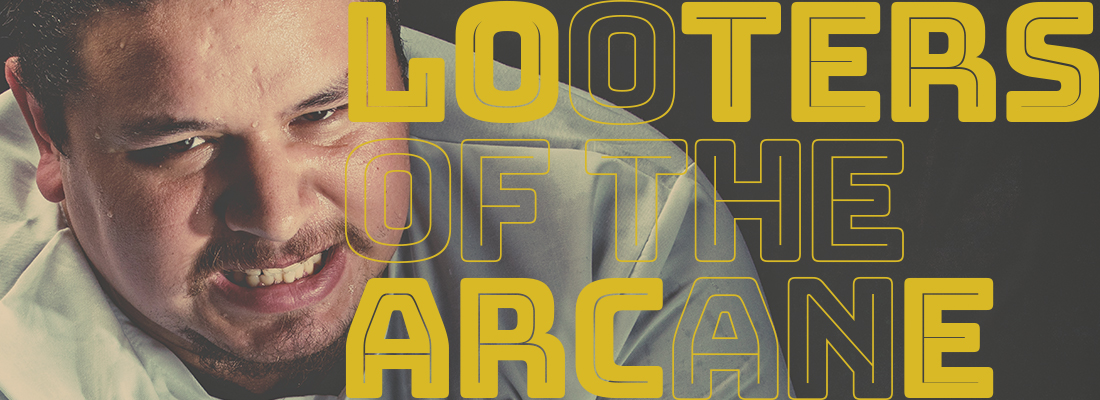
Looters of the Arcane is a post-modern survival horror game where players travel to past eras to find mysterious objects. With the use of a Time Sphere, players can collect these objects for the antiquities company they currently work for in the distant future.
The purpose of the game is to find the arcane objects and sell them to the highest bidder. Because the lost objects are things that shaped the current world, the game has a surreal effect.
Creator Regis Jerry says this game is an “environment with a personality.” Also known as True PVE, this sets the game apart from other PVE games and gives it an innovative factor. The game’s AI gives the player a completely immersive experience through environmental challenges thrown at the player.
As a player levels up, the environment becomes more difficult to beat. This sense of differing personalities gives the player the ability to use the environment or let it hinder them. Visit places like Ancient Egypt, The Asylum, Ancient Greece and Feudal Japan.
Players can use guns and crosses found within the different environments to fight off elements of the environment that is trying to kill them.
You can play Looters of the Arcane on Steam for free.
Are you interested in the gaming industry? UAT offers degrees in Game Design, Game Programming and Game Art and Animation.
